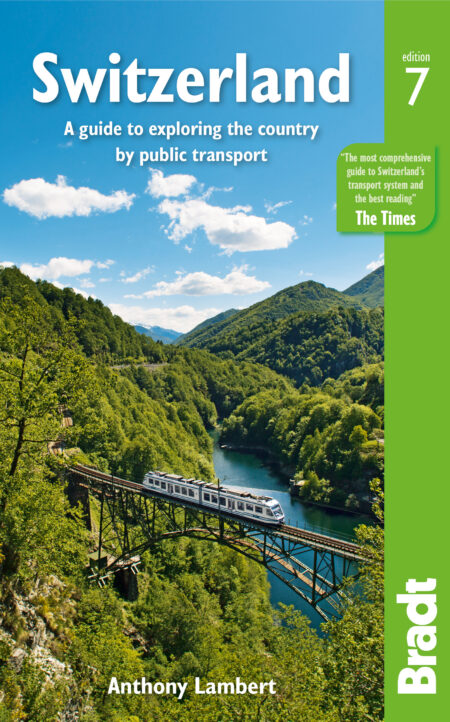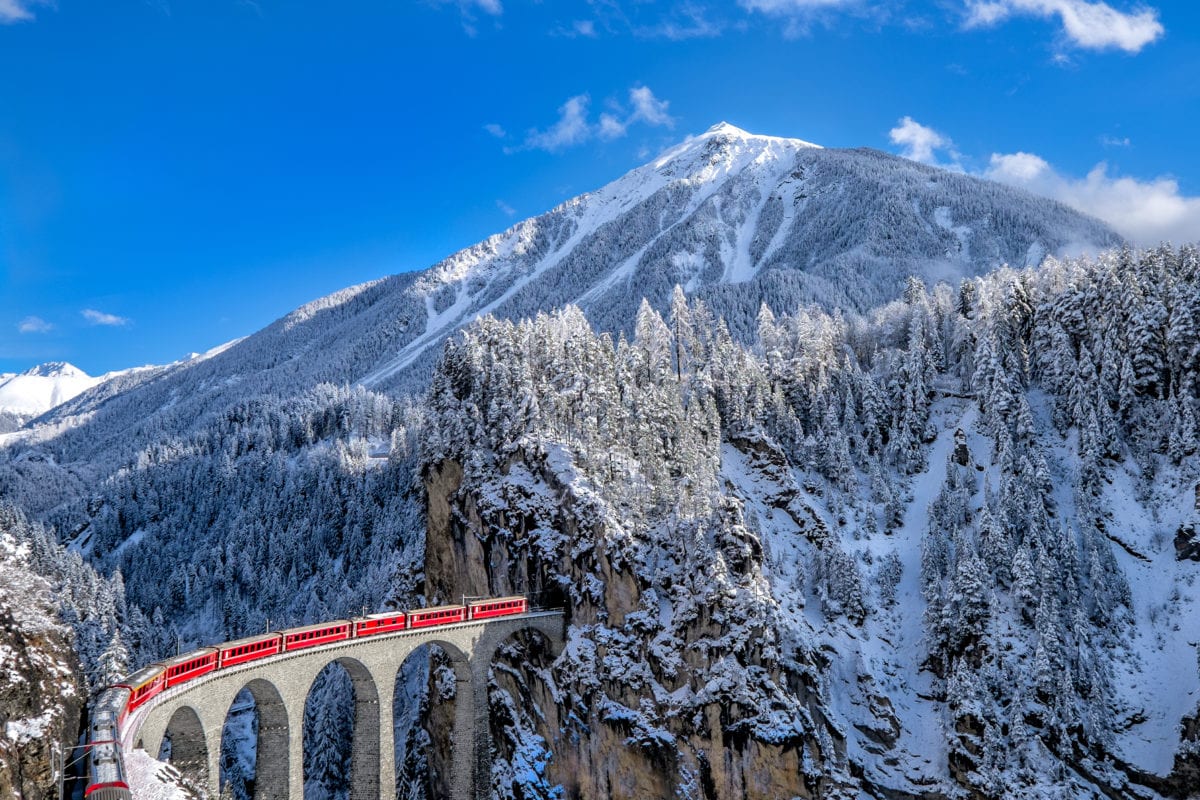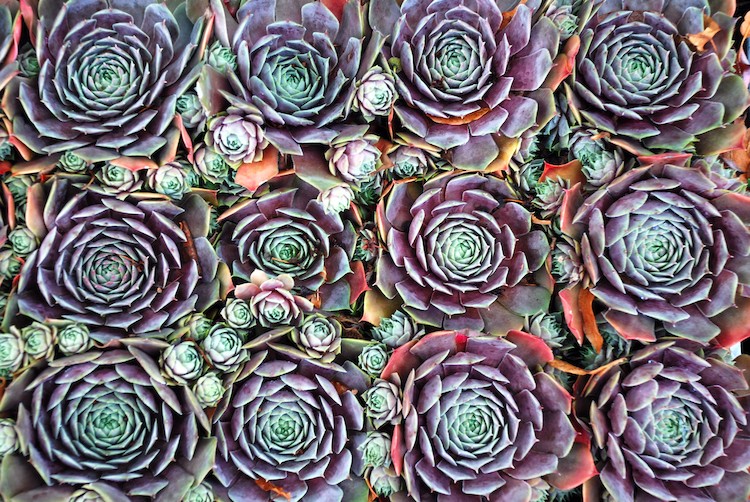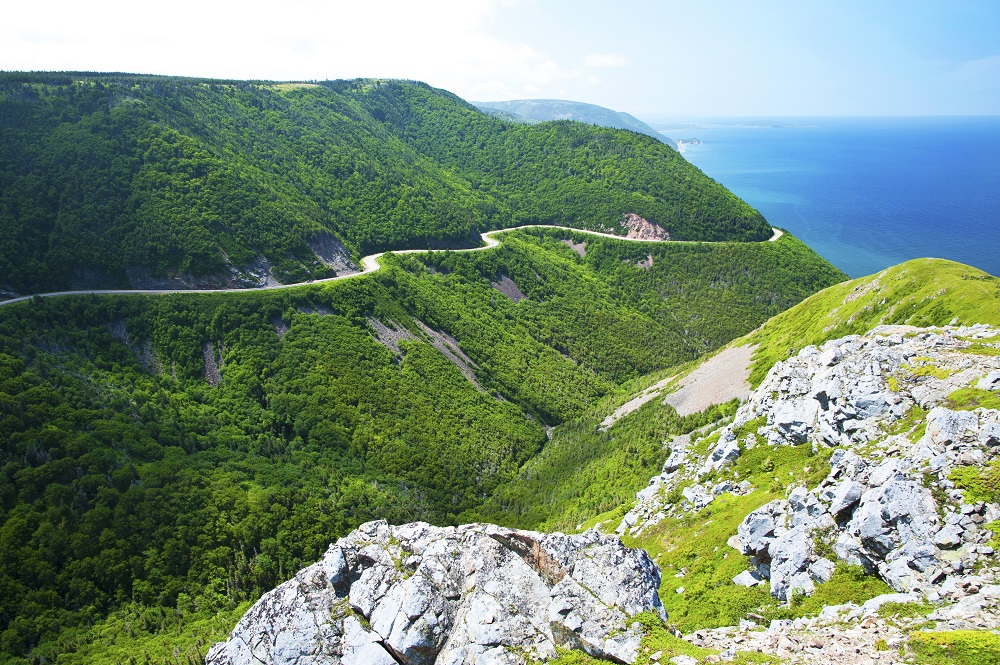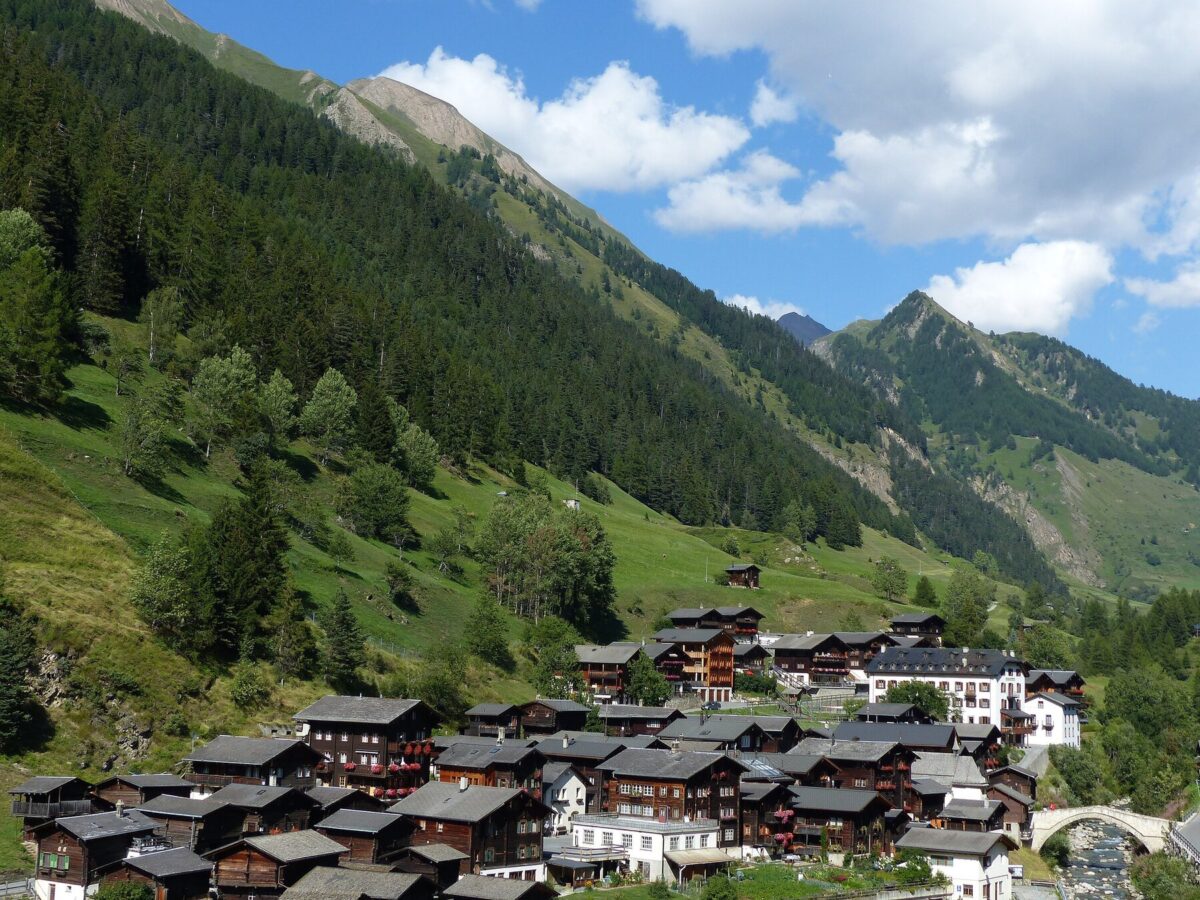Switzerland is a paradise for those who prefer peace and solitude to noise and crowds.
Anthony Lambert, author of Switzerland: the Bradt Guide
Switzerland is one of our hot destinations for the year ahead – check out the full list of the best places to travel in 2024 here.
Switzerland is synonymous with some of the most beautiful mountain landscapes on earth. It is primarily to see sights such as the Jungfrau, Eiger and Matterhorn that over 12 million people a year visit Switzerland, with UK visitors third only to Germany and the US.
Tourism promotion is the catalyst for most visitors today, but curiously it was mainly the writings of poets and playwrights which encouraged the early tourists to visit the country – the third canto of Byron’s Childe Harolde, Schiller’s Wilhelm Tell and Rossini’s opera based on it did more for Swiss tourism in the first half of the 19th century than any official promotion. This celebration of the country’s natural beauty by writers and painters has, however, distorted the view of what Switzerland has to offer.
Because the landscape dominates most visitors’ perceptions of the country, its architectural and cultural attractions have been relatively neglected. The principal art galleries, for example, have collections of paintings that would hold their own with most capital cities. The country has thousands of fine museums, castles, mansions and outstanding churches, as well as delightful vernacular buildings.
The country’s cities are a pleasure to visit, partly because the impact of motor traffic has been minimised. Mercer’s 2019 Quality of Life Survey of world cities ranked Zürich, Geneva and Basel respectively as second, ninth and tenth. Zürich has been in first or second position for more than 15 consecutive years. As the British/Swiss comedian Dom Joly put it, the country ‘somehow enthuses one with a feeling everything is right with the world’.
Switzerland is a paradise for those who prefer peace and solitude to noise and crowds, although the larger cities have plenty of opportunities for those in search of lively and cutting-edge nightlife.
See also this guide to the most scenic train rides in Switzerland.
For more information, check ot our guide to Switzerland
Food and drink in Switzerland
Food
The perception of Swiss cuisine as being all about chocolate and cheese, fondue and rösti is as old hat as suggesting that fish and chips exemplify British cuisine.
Fondue and rösti still feature as national dishes, but food and wine in Switzerland have undergone a revolution in the past three decades. As with so many aspects of Switzerland, there has been an emphasis on quality, helped by consumer demand for produce that is organic – or bio as it’s usually termed. Switzerland was the second country, after Italy, to establish a Slow Food movement, strongly supported by the Coop from the early 1990s.
This chimes with federal support given to mountain farms to help them maintain the non-food aspects of agriculture that are valued and need to be rewarded if marginal hill and mountain farms are to survive – the appearance and beauty of the landscape, rainwater retention, carbon capture and soil quality.
Growing interest in what we eat has helped to raise consumer expectations when they visit a restaurant, driving higher standards of ingredients and cooking. This has complemented one of Switzerland’s strongest culinary attractions: its three national cuisines drawn from France, Germany and Italy. Within the first two, comprising a number of cantons, there are also numerous regional and local specialities. As a consequence, Switzerland has a culinary richness matched by few other countries.
Vegetarians and vegans will have no difficulty finding delicious dishes in the cities. Haus Hilti in Zürich is the country’s oldest vegetarian restaurant, founded in 1898, and just one of a number of solely vegetarian restaurants. It draws inspiration from France, Greece, Italy, India, Lebanon and Thailand.
The two products most associated with Switzerland are chocolate and cheese. There are hundreds of dairies open to visitors or selling their cheeses, and some chocolate producers have factory tours and shops, notably Cailler at Broc. Swiss chocolate production originated in the 17th century, but the household names date from the 19th: Cailler, Suchard, Sprüngli, Lindt, Tobler and Frey.
Drink
In common with nearly all Western countries, the Swiss beer scene has been revolutionised by the establishment of craft breweries to challenge the four main big breweries of Calanda (Chur), Eichhof (Luzern), Feldschlösschen (Rheinfelden) and Rugenbräu (Interlaken). In fact, Switzerland has the highest concentration of breweries per capita in the world, though over 70% of beer consumed in the country is still German lager style, and it is a challenge for craft breweries to broaden consumers’ tastes.
Wine production, too, has undergone a transformation. Until recently many Swiss wines were a disappointment, not helped by Swiss wine merchants being allowed to mix imported and Swiss wines, a practice banned in 2006. Today the quality has improved so much that there is no need to order imported wine, but most visitors’ knowledge of Swiss wines is minimal since the Swiss drink it all: less than 2% is exported and most of that goes to Germany, so it takes time, or a sommelier’s advice, to develop personal choices.
The best-known vineyards stretch for 30km along the northern slopes of Lac Léman, passed by trains between Geneva and Montreux. The Lavaux Vineyard Terraces in Vaud were created by Benedictine and Cistercian monasteries in the 11th century and are now a World Heritage Site. The other principal wine-making cantons are Geneva, Graubünden, Ticino and Valais, which has Europe’s highest vineyard at Visperterminen where the vines are at 650–1,150m (2,132–3,773ft) above sea level.
The dominant grapes are Pinot Noir and Chasselas, followed by Gamay and Merlot, but there are many esoteric varieties such as Petite Arvine and Completer. The latter was revived from near-extinction by the Graubünden winemaker Martin Donatsch, who became world champion Pinot Noir producer in 2010 and 2011 from his 6ha of vines.
For those with a serious interest in wine, there are wine museums in Aigle, Au (near Wädenswil), Boudry, Salgesch and Sierre.
Health and safety in Switzerland
Health
Since there is no state health service in Switzerland, nor reciprocal agreements for free treatment with other countries, it is imperative that you take out health insurance, especially if you are taking part in sports or mountain walking.
Switzerland has very high standards of hygiene, so neither food nor tap water should pose any hazard, but it is not advisable to drink from mountain streams, however clear they may look.
In parts of the country, the mosquitoes can gather in rather dense clouds during the summer. Apply a DEET-based product to prevent being bitten and consider a hat with a net to keep them away from your nose and eyes.
Safety
Travelling with a disability
Switzerland caters well for someone travelling with a disability. Far fewer stations need hoists to elevate a wheelchair from a low platform thanks to the raising of platform heights. There is a large and exemplary section in English on the Swiss Federal Railways website devoted to helping passengers with disabilities.
The Royal Association for Disability & Rehabilitation and Switzerland Tourism offer information. Hotels of three stars and above can be expected to have lifts. The UK’s gov.uk website has a downloadable guide giving general advice and practical information for travellers with a disability (and their companions) preparing for overseas travel.
Provision for disabled access inevitably varies widely on mountain cableways and railways. Chairlifts and gondola lifts, which are usually boarded while in continuous motion, are obviously difficult if not impossible, but modern or rebuilt cable cars can sometimes accept wheelchairs.
Safety when mountain walking
Mountain walking and hiking are hugely popular activities in Switzerland but a few precautions are required to ensure your safety.
- Hiking boots are essential.
- Plan routes bearing in mind the limitations of the weakest member ofthe party, and do not go alone unless you are highly experienced.
- A first aid kit, provisions, protective clothing, a small torch andtopographic maps are essential.
- A telescopic walking stick will help with descents.
- The weather in mountain areas can change rapidly, so it is advisableto obtain a forecast before setting out and to be prepared fordeteriorating conditions.
- Always tell someone where you are going and what time you expectto return.
- Set off early and plan to return early, allowing time to return if youencounter difficulties.
- Be careful if lighting a fire, and never do so in dry weather.
- Close gates behind you, be careful of plants and animals, and do notleave any litter.
Travel and visas in Switzerland
Visas
Tourist visits totalling no more than 90 days over any 180-day period by nationals of the European Union, Australia, Canada, New Zealand and the US do not require a visa. UK passport holders can visit Switzerland without a visa for up to 90 days over any 180-day period. Check before travelling.
Getting there and away
By rail
The Channel Tunnel and Eurostar services to Lille, Paris Gare du Nord and Brussels have transformed the rail map of Europe, opening up possibilities for practical day journeys to Switzerland. TGV (Train à Grande Vitesse) services to Switzerland are operated by Lyria, a Swiss and French railways joint venture, which began in June 2007.
Trains leave from Paris Gare de Lyon, reached from Gare du Nord by taking RER Line D for just two stops (direction Melun/Malesherbes). The opening of the high-speed LGV (Ligne à Grande Vitesse) Rhine/Rhone in December 2011 reduced journey times between Paris and Basel/Zürich by half an hour. Journey time from the French capital to Basel is 3 hours, to Zürich 4 hours, Geneva 3 hours, Lausanne 3½ hours, Neuchâtel 4 hours, Bern 4½ hours and Interlaken 5½ hours.
For those combining a visit to Switzerland with other countries, the range of trans-European trains is impressive. The following principal stations in Switzerland are linked by direct services with the cities that follow:
- Basel Amsterdam, Berlin (Nightjet and ICE – Inter-City Express, the German high-speed train), Cologne, Dortmund, Düsseldorf, Frankfurt (ICE), Hamburg (ICE), Hanover, Milan, Paris (TGV), Strasbourg
- Bern Berlin (ICE), Cologne, Frankfurt, Hamburg, Milan
- Geneva Grenoble, Lyon (TGV), Milan, Paris (TGV), Valence, Venice
- Interlaken Berlin (ICE), Frankfurt (ICE)
- Lausanne Milan, Paris (TGV), Venice
- Zürich Amsterdam (Nightjet), Berlin (Nightjet), Bratislava (Nightjet), Budapest, Cologne, Düsseldorf (Nightjet and EuroCity; EC), Frankfurt (ICE), Genoa, Hamburg (Nightjet and ICE), Innsbruck, Koblenz, Ljubljana, Milan, Munich, Paris (TGV), Prague, Salzburg, Stuttgart, Venice, Vienna, Zagreb
By air
Three Swiss airports receive regular flights from the British Isles: Basel, Geneva and Zürich. The easiest connections between air terminal and railway station are at Zürich and Geneva where the two facilities are adjacent. Both have frequent train services to many parts of Switzerland. Currently there are flights to:
- Basel from: Bristol, Dublin, Edinburgh, London Gatwick, London Heathrow and Manchester
- Geneva from: Aberdeen, Belfast International, Birmingham, Bournemouth, Bristol, Dublin, East Midlands, Edinburgh, Glasgow, Leeds Bradford, Liverpool, London City, London Gatwick, London Heathrow, London Luton, Manchester, Newcastle and Southampton
- Zürich from: Birmingham, Dublin, Edinburgh, London City, London Gatwick, London Heathrow, London Luton and Manchester
- North American airports served by Swiss include: Atlanta, Boston, Chicago, Las Vegas, Los Angeles, Miami, Montréal, New York, Orlando, Ottawa, San Francisco, Toronto, Vancouver
Getting around
Switzerland has the densest network of public transport in the world. For two-thirds of Swiss people it is less than 5 minutes’ walk from their homes to the nearest public transport; 97.5% live less than a kilometre away. Besides just over 5,000km (3,125 miles) of state- and privately owned railways, there are 936 postbus routes operated by over 2,400 vehicles and over 600 funiculars, cable cars, rack railways and chairlifts. With local transport and steamer services, this amounts to a public transport network of about 28,382km (17,636 miles).
By rail
A range of rail passes has been created to suit the travel requirements of most visitors. These not only make use of the system much easier; they also represent excellent value (and accompanied children under 16 travel free).
The Swiss Travel Pass entitles the holder to unlimited travel for 3, 4, 6, 8 or 15 consecutive days on more than 28,000km (17,000 miles) of railway, boat and postal bus networks and on the municipal transport systems of over 90 towns and cities. It also entitles the holder to 50% discounts on nearly all mountain railways and aerial cableways.
There is also a wide range of regional passes which usually cover trains, buses and boats, but the precise scope and conditions should be checked.
Postbuses
The Swiss postbus system, operated by Swiss Post (PTT), has a network of 936 routes covering over 16,865km (10,541 miles) with 2,238 vehicles. It evolved from the 19th-century mail coach service, which in 1913 was using 2,523 horses, 2,231 coaches and 1,059 sleighs, and on which the first motor service between Bern and Detligen was introduced in 1906. Postbuses operate all non-urban services and are painted in distinctive yellow livery with a red band.
By car
Given the extent of Swiss public transport, there is almost nowhere that cannot be reached by it and a short walk. However, if using a car is unavoidable, around 3,000 Click & Drive hire cars are available at over 1,500 points, mostly railway stations – provided by Mobility for a basic charge covering 3 hours.
To use this pay-by-use offer, an initial registration with a driving licence is necessary, most easily completed by smartphone app and following the instructions before a journey. After completing this procedure, you will be able to reserve your car online. There are seven different categories of vehicle to choose from, including small budget cars, electric cars and seven-seater minivans. Visit mobility.ch/tourists for further details.
When to visit Switzerland
There is almost no time in the year when a visit to Switzerland is inadvisable. Even in the unpopular month of November, one can be lucky and have glorious sunshine – and benefit from low-season prices. Much depends on the area and altitude. May in the mountains, for example, is often not a good time to visit: many of the major hotels, mountain cableways and funiculars will be closed because it is too late for skiing and too early for walking or spring flowers. June and even July are the best months to see the mass of colour on unsprayed mountain slopes.
It is wrong to think of Swiss alpine resorts in winter as being devoted solely to the needs of skiers: about 40% of winter visitors are non-skiers, though most participate in other outdoor activities such as hiking, snowshoe trekking, paragliding or sledging.
Skiing at the higher resorts can be good right into April, and even year-round at the very highest slopes near Saas-Fee and Zermatt. Rainfall in spring and autumn is generally higher than during the winter or summer, but rain often serves to clear the air, producing a clarity that is rare in summer when haze can obstruct views.
The Jura region, in particular, is noted for its high spring rainfall. Although some hotels close for a couple of months in late September or October, the autumn can be a delightful time: the summer crowds are gone, the colours of the trees are glorious and the views can be much clearer than during the summer. Most mountain cable cars and chairlifts close at the end of October to allow maintenance before the winter sports season begins.
The mountain ranges that criss-cross the country often act as a dividing line between two very different sets of weather conditions: the passage of the Gotthard Tunnel can mark a transition from grey skies to bright sunshine. South of the Alps, the number of hours of sunshine is higher and precipitation lower, so those wanting a warm holiday at the margins of the summer may want to consider a few days in Ticino.
What to see and do in Switzerland
Aletsch glacier
The view down the Aletsch glacier is spectacular, the great tongue of ice weaving its way downhill; at 21.6km (13½ miles) it is Europe’s longest glacier, stretching south towards the Rhône valley close to the Brig–Andermatt railway. From the end of June until early October, a two-day hike over the glacier is offered to those who are fit and have a head for heights, overnighting in the Konkordia hut.
Railway routes
The glacier is best accessed when travelling on one of Switzerland’s many railway routes.
Geneva – Martiny – Brig
This fast stretch of line along the Rhône valley serves some of Switzerland’s most popular skiing resorts, reflected by the through TGV service to/from Paris on winter Saturdays. The broad valley itself alternates between fruit growing and industry, while every parcel of land on the slopes seems to be planted with vines.
On the outskirts of Brig, the bus stops at Ried bei Brig, where a gondola ascends to Rosswald, a car-free village with a fine view west along the Rhône Valley. Another bus route serves the region at the foot of the Aletsch glacier, starting from beneath the Jungfrau, as it curves southwest towards Belalp. The bus goes from Brig station through the historic villages of Naters and Geimen to Blatten bei Naters.
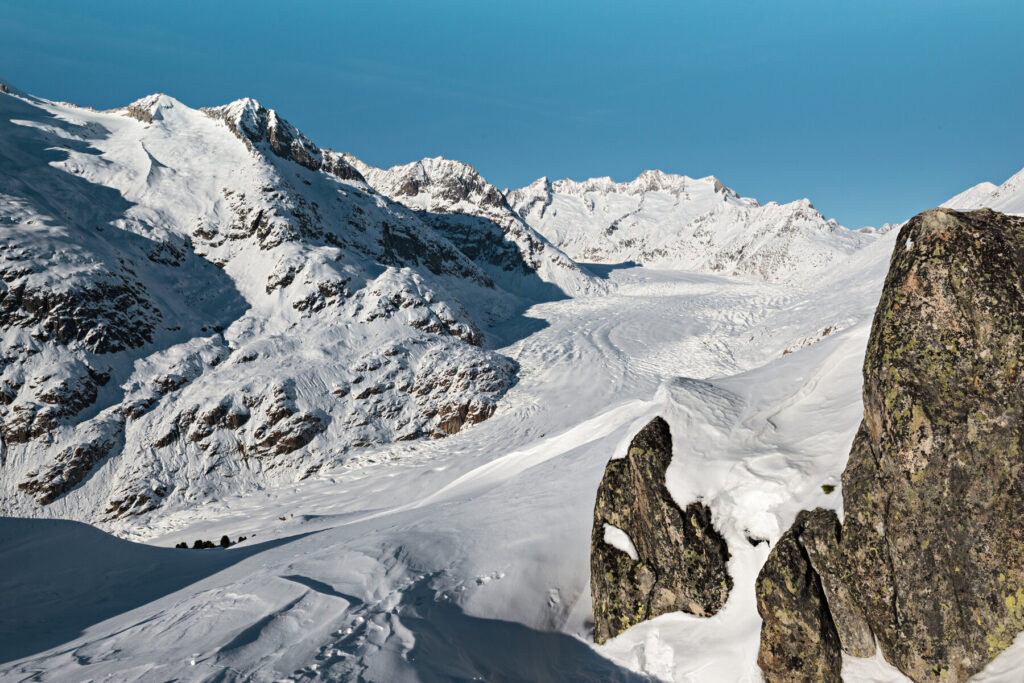
From here a cable car ascends to Belalp for a fine view of the glacier. The first non-Swiss known to have visited Belalp was Ruskin, in 1844. Belalp is the start of the UNESCO Panoramaweg walk to Riederfurka, a 16km (10-mile) hike which packs in wildflower pasture, glacier views and magnificent mountain vistas, plus a spectacular suspension bridge.
Brig – Andermatt
This section of the Glacier Express continues up the Rhône Valley into the eastern part of the Upper Valais known as the Goms, with the first spiral tunnel of the journey. Along the ridge to the north of the railway is the lovely Arolla pine forest of Aletsch, which offers fine walking. Some of the villages are also small ski resorts.
Until December 2007, trains had to reverse at Brig, but a new alignment along the south side of the River Rotten/Rhône created a through station. The much-rebuilt medieval Catholic church at Mörel has 16th- and 17th-century wall paintings, and a walk of 1 or 3 minutes from the station are two cable cars to the car-free resort of Riederalp.
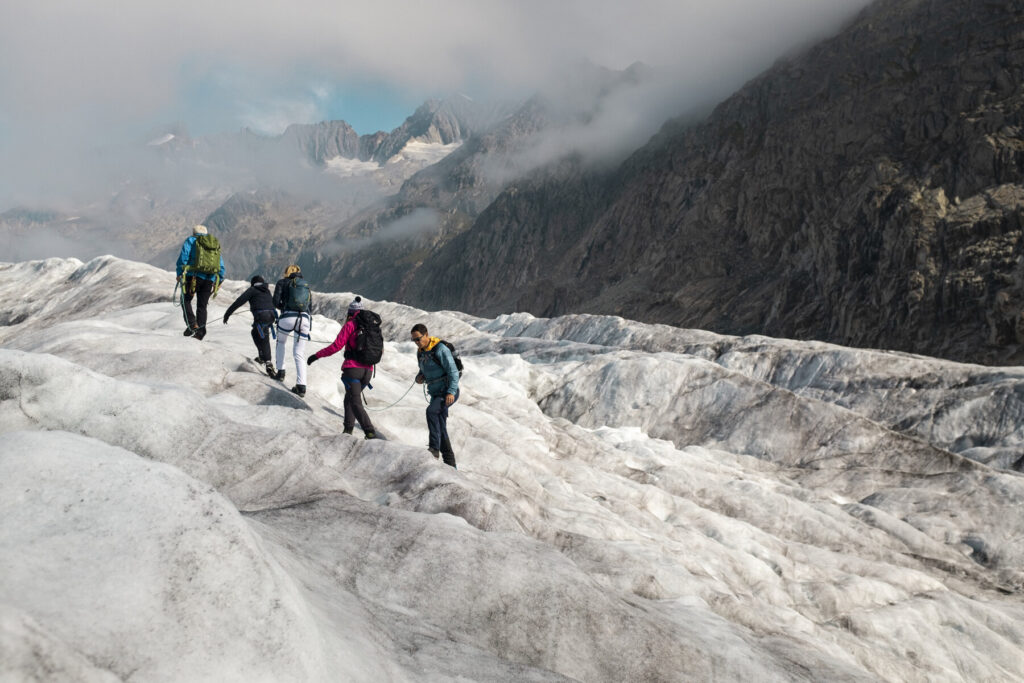
With Bettmeralp and Fiescheralp, Riederalp forms the largest car-free area in Europe with the World Heritage Site of the Aletsch Arena and Europe’s longest glacier behind the 8km shelf of rock. A chairlift continues to Moosfluh, which is at one end of the Aletsch Panoramaweg, the 12.4km path to Fiescheralp that provides some of the best views over the glacier.
Five minutes’ walk from Fiesch station is the two-section cable car to Eggishorn from which there are outstanding views along the great Aletsch Glacier, Europe’s longest at about 24km (15 miles). In contrast to the view of the glacier from places such as Jungfraujoch, from here you get a much better idea of its immense size.
Bellinzona castles
Bellinzona was developed from Roman times thanks to its strategic position at the entrance to three passes – Gotthard, Lukmanier and San Bernardino. To reach the tourist office from the station, turn left along Viale Stazione to arcaded Piazza Nosetto on which the office may be found. This, with the adjacent Piazza Collegiata, is the heart of the old town in which a colourful market is held on Saturday mornings. The latter takes its name from the large collegiate church of Santi Pietro e Stefano, a much-rebuilt largely Renaissance church which has elaborate 17th–18th-century stucco.
Beside the church is a pedestrian alley that climbs the hill to one of Bellinzona’s three castles, all of which have survived largely intact and which constitute some of Switzerland’s most dramatic military buildings. Their importance is reflected in the three being a World Heritage Site. The three are also known by the names of the three cantons which prosecuted the policy of bringing the canton under Swiss hegemony and which installed their bailiffs in them.
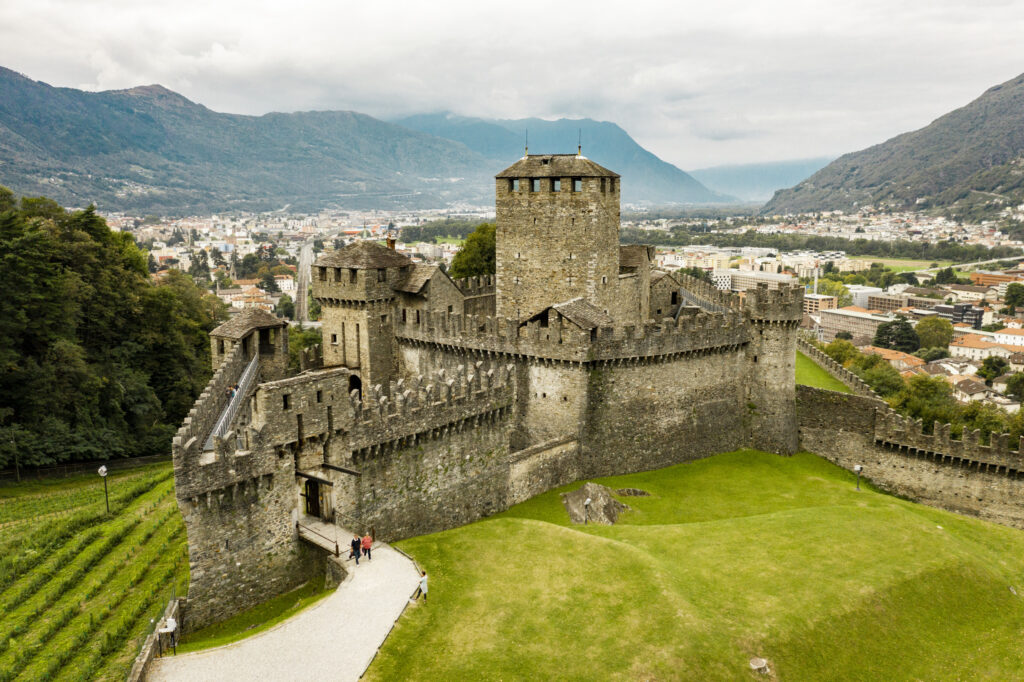
Castello di Montebello
The Castello di Montebello (Castle of Schwyz) was begun at the end of the 13th century and progressively enlarged to consist of two multi-towered curtain walls surrounding a rectangular five-storey keep and a gate-tower.
The fortress’s slender and uniform machicolations belie the different building periods. It houses the Civic Museum of archaeological and historical artefacts. One ticket (the Bellinzona Pass) covers all three castles and the Villa dei Cedri civic museum.
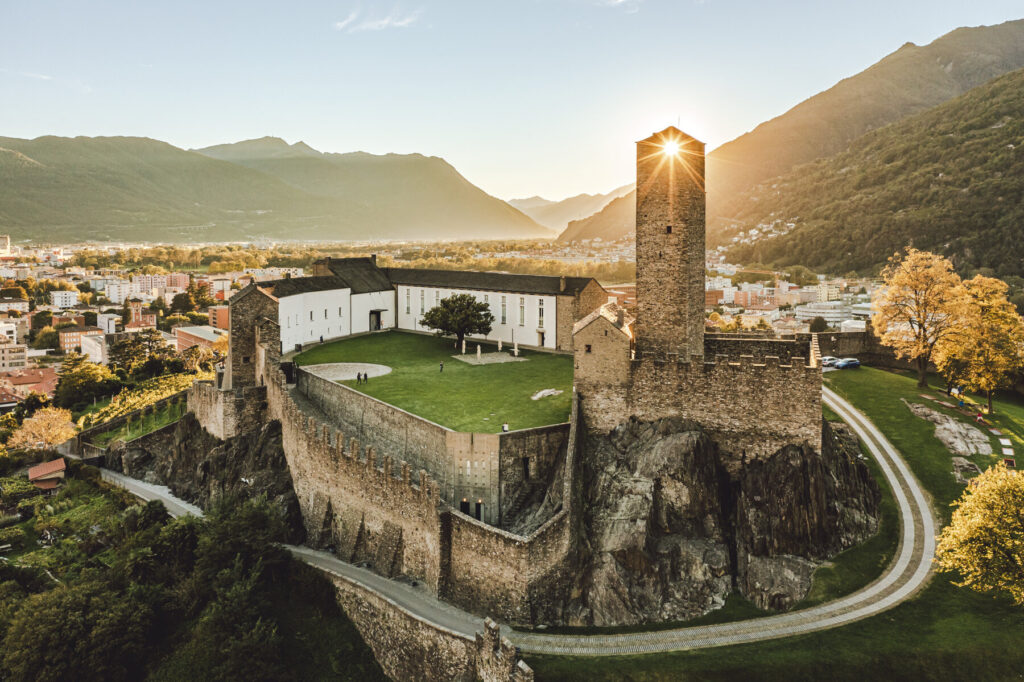
Castelgrande
On the other side of Piazza Collegiata is Castelgrande (Castle of Uri), the oldest and largest of the three, dating from the 12th century. The castle is dominated by two tall 13th-century towers, one a keep, the other residential. The museum is devoted to interpreting the site through the 6,500 years of its occupation, from Neolithic times to the present.
It has a restaurant reached by a lift shaft through the rock as well as by steps. One of its walls was built to close off the valley, being crenellated on both sides and the wall ‘walk’ wide enough for four horses to ride abreast.
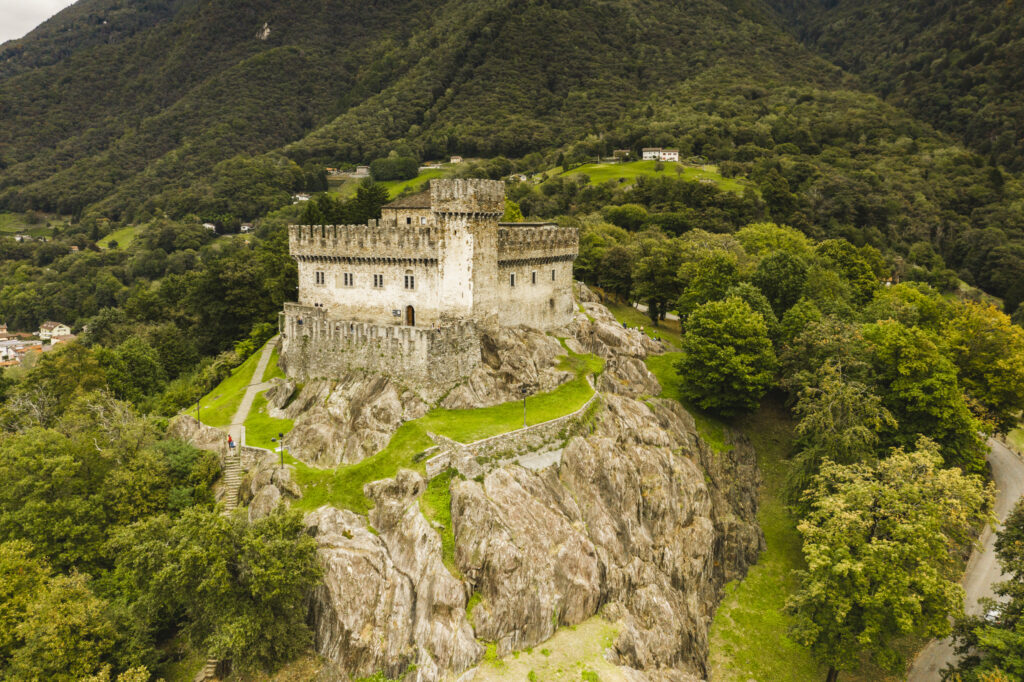
Castello di Sasso Corbaro
The third castle, Castello di Sasso Corbaro (Castle of Unterwalden), lies outside the old town and is approached by a winding road leading to its two working drawbridges. The castle is reputed to have been built in just six months by Sforzas following the defeat of Milanese troops at Giornico.
Some walls are 4.7m thick. In the castle is a museum of folk art, including a beautiful 17th-century panelled room with stove from a house at Olivone in the Blenio Valley.
Bern
Although Bern has been the capital of the Swiss Confederation since 1848, it is only the fifth-largest city, after Zürich, Geneva, Basel and Lausanne, with a population of 122,000. Few cities in Europe can rival Bern for the way that it has kept its medieval centre intact; UNESCO has recognised this and placed the city on its list of World Heritage Sites, on a par with the centres of Rome, Florence and Havana.
It is renowned for its fountains, towers and bridges, the profusion of geranium-filled windowboxes and the 6km (4 miles) of arcades, the Lauben, that line many of the streets of greenish-grey sandstone buildings.
In addition to its exceptional buildings, Bern has numerous museums, art galleries and theatres, and a vibrant musical life, helped by being home to the Swiss Jazz School and an International Jazz Festival, held every year from March to May.
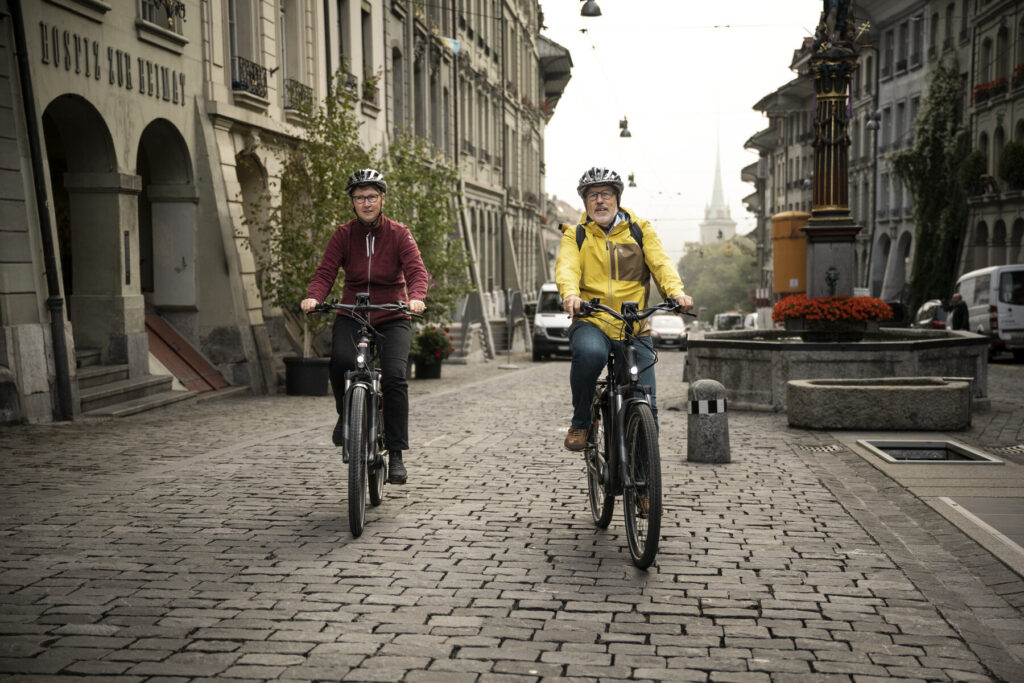
The old town
Thanks partly to its modest size and partly to the confined location of the old town, Bern is a city that can only be properly explored on foot or by bicycle.
Bahnhofplatz
A remnant of the old town can be seen even before leaving Bern HB: when the station was reconstructed in the 1970s, the decision was taken to preserve the foundations of the city’s historic walls and the Christoffel Tower as part of the huge shopping area and station complex underneath Bahnhofplatz.
Above ground the square has two buildings of note. To the right of the station is the citizens’ hospital (Burgerspital), a rectangular building built between 1734 and 1742, with a central courtyard like the Hotel des Invalides in Paris (1734–42). Opposite is the Church of the Holy Ghost (Heiliggeistkirche), which has been described as the most important Protestant Baroque church in Switzerland. The vast columns, stuccoed vaults and galleries were put up between 1726 and 1729.
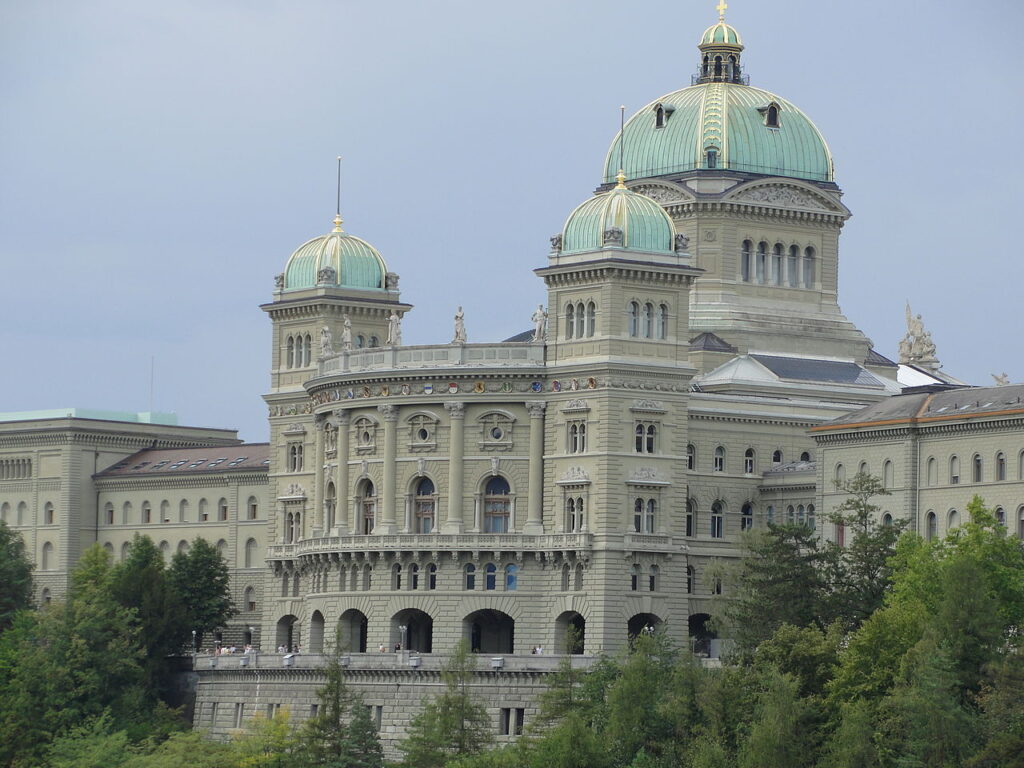
Houses of Parliament
Turn right into Bundesplatz and straight ahead are the Houses of Parliament(Bundeshäuser), built in stages between 1851 and 1902. The interior is open to the public for guided tours outside of parliamentary sessionsand includes the two debating chambers. The square was revamped in 2004 with new lights and a water display of 26 fountains representing the cantons.
From the south side of the Parliament building, walk along the terrace overlooking the Aare to the end of the Kirchenfeldbrücke at the south end of Casinoplatz, named after the 1909 casino on the opposite side of the road. Turn left (north) into Casinoplatz and proceed to the contiguous Theaterplatz, where the unusual single-storey, columned building with gabled roof was erected between 1766 and 1768 as a guard room and later became the police headquarters.
Bern Cathedral
Bern’s most impressive church began construction on 11 March 1421 on the site of an existing church, which was gradually surrounded by the new edifice but which remained in use for over 30 years before being dismantled and carried out stone by stone through the new portal.
Work began under Matthäus Ensinger, one of a family of cathedral builders from Ulm who had proved their worth in Ulm, Strasbourg and Esslingen. By 1517, much of the main work had been finished, but during the Reformation many of its treasures were destroyed.
However, the magnificent tympanum over the principal entrance was spared, perhaps, it has been conjectured, because the extraordinary mélange of 238 individually sculptured figures includes depictions of the Last Judgement. The Apostles and the wise and foolish virgins may also be seen.
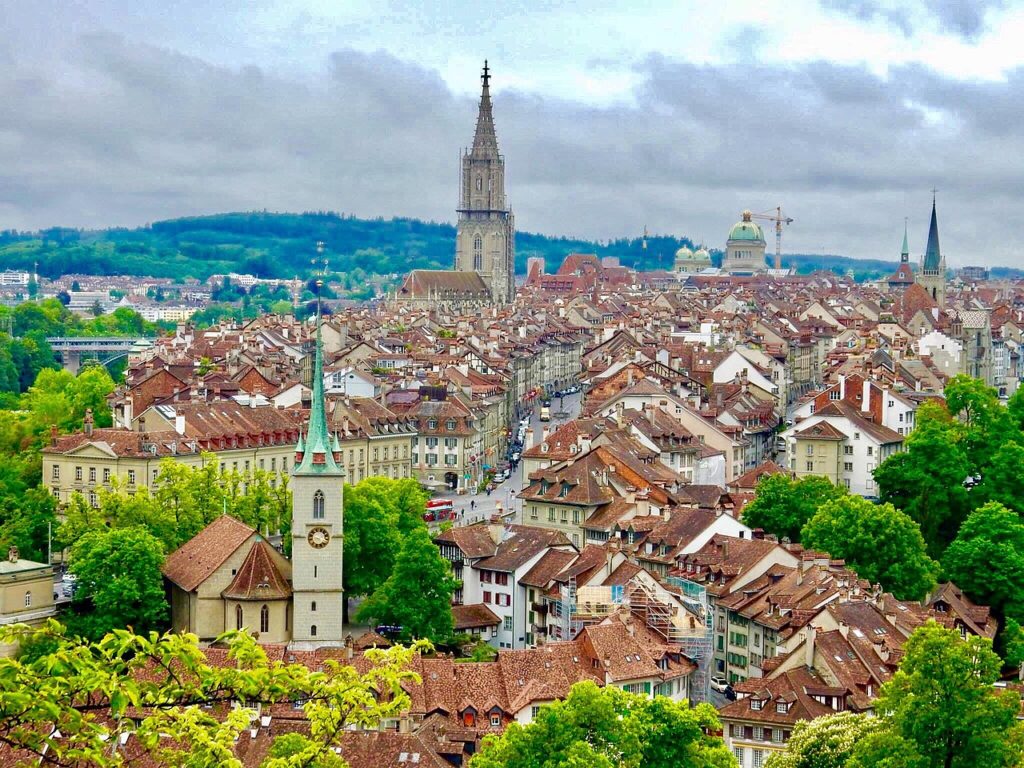
Rose Garden
The Rose Garden offers one of the best views of the city. Much of the sandstone for Bern’s reconstruction after the fire of 1405 was taken from the area below the Rose Garden, which accounts for the width of the road at the foot of the slope. Return across Nydeggbrücke and proceed straight ahead into Gerechtigkeitsgasse.
The figure on the Justice Fountain holds the scales of justice and a sword while the pope, the sultan, the Holy Roman emperor and the mayor of Bern sit at her feet, representing theocracy, monarchy, autocracy and democracy, respectively.
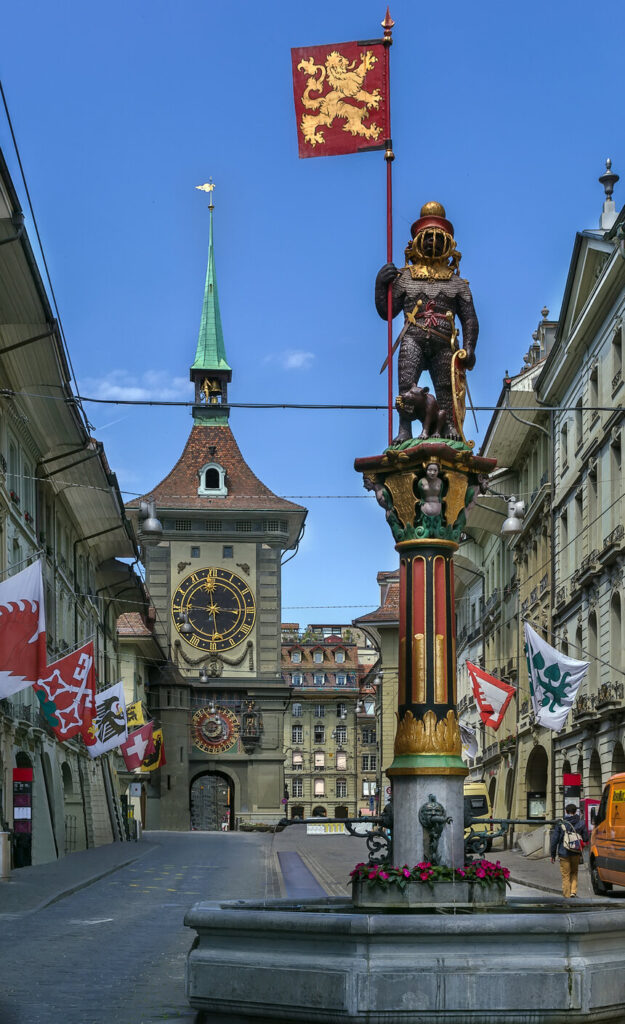
The Clock Tower
The Clock Tower (Zeitglockenturm) is Bern’s oldest building and probably its best known. It formed the main gateway to the town’s first western wall, its earliest stonework dating back to the 12th century. The side facing the city was open and made of wood until reconstructed in stone after the fire of 1405.
The clock was not only the official time by which other clocks were set, but also the point from which distances for cantonal mileposts were measured. In its archway, the standard measurements of meter and double meter are visible, formerly ‘Elle’ and ‘Klafter’.
The tower’s bell was cast in 1405 and rung by hand for 125 years. In 1530, Casper Brunner completed work at his workshop within the tower on the astronomical clock and mechanical figure play that have made the Clock Tower such an attraction for visitors ever since.
Fountains
On the right in Kornhausplatz is Bern’s most gruesome fountain, the Ogre Fountain. The significance of the ogre devouring a child is a matter of conjecture: that perhaps it refers to the Greek myth of Cronus (who swallowed his children at birth to thwart a prediction that one of them would supplant him); or that it alludes to the false accusation of ritual Jewish murder once thought to have been practised in the late 13th century.
Continuing east towards the station, you come to the Musketeer Fountain (1543) in Marktgasse, which has an armoured commander figure. Further on is the Anna Seiler Fountain, supposedly named after one of the city’s early benefactors who, in 1354, gave her home and fortune to found the Insel Hospital, which began with 13 beds (today it has about 1,000).
The bridges
Until 1844, the only fixed crossing of the River Aare was by the stone Untertorbrücke (1461–89) which replaced an earlier wooden structure. It still survives at the eastern end of the peninsula, along with the 13th-century gate-tower on the east bank known as the Felsenburg, which was converted into a residence between 1862 and 1864.
Opened in 1844, the Nydeggbrücke was the first high-level bridge across the river and came equipped with a pair of customs houses. It was followed in 1858 by the first railway bridge, which stood on the same site as the present reinforced concrete bridge put up in 1941.
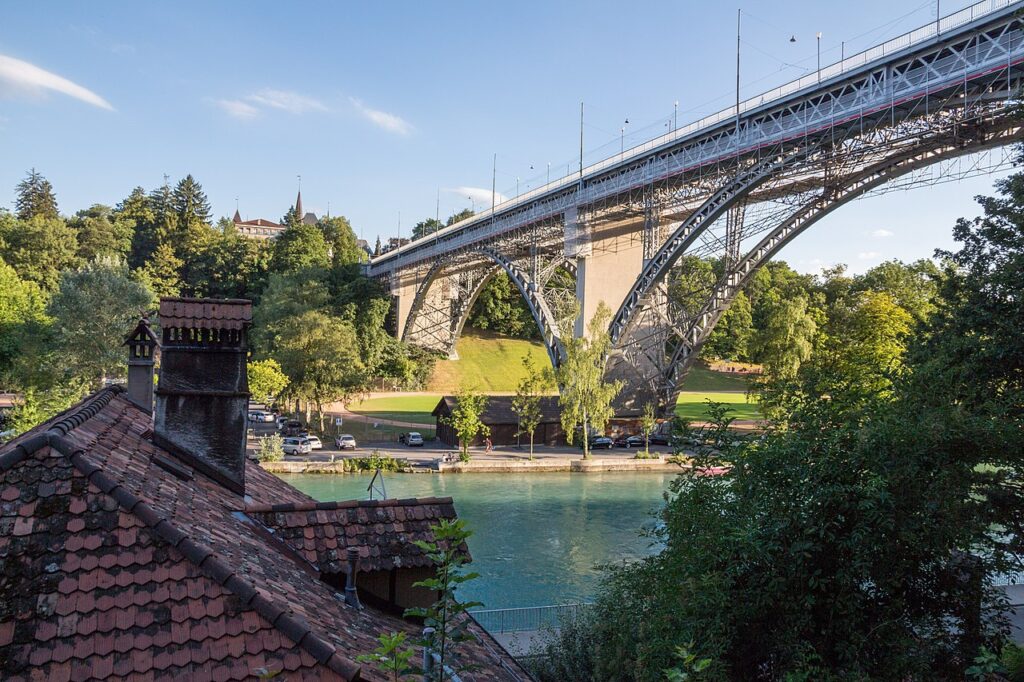
A British company was responsible for the 230m-long (755ft) Kirchenfeldbrücke, which opened in 1883 and still carries both motor traffic and trams. The Bern Land Company bought land south of the Aare, and one of the three conditions of purchase stipulated that the buyer must construct a bridge over the river.
The elegant Kornhausbrücke provides the longest span across the Aare at 115m (377ft); completed in 1898, it also carries both motor traffic and trams.
Historical Museum of Bern
Switzerland’s second-largest historical museum is housed in a purpose-built mock medieval castle designed by André Lambert and opened in 1894. It contains a marvellous variety of displays, ranging from prehistory and early history to dioramas of 19th- and 20th-century life. Rooms are devoted to Burgundy and the republic of Bern, the Christian view of life, the growth of the city, high society under the Ancien Régime and everyday life.
There are large collections of coins, armour, jewellery, glass, ceramics, utensils, bronzes, mosaics, textiles and costumes, furniture in reconstructed rooms, and maps and altars. One of the most unusual exhibits is an extraordinary series of 280 portraits of men and women of rural background conceived as a single ethnographic project in the 18th century.
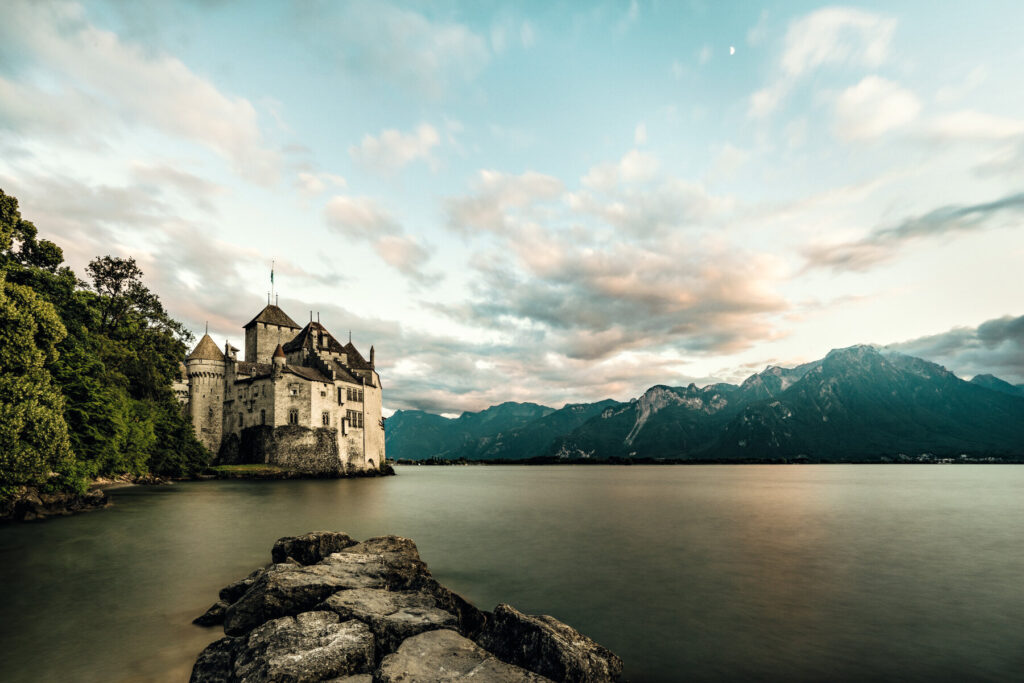
Chillon Castle
The castle
Even if Byron had not written The Prisoner of Chillon, Chillon Castle would still be the outstanding attraction it has become; not only is its position on a peninsula strikingly picturesque, but it is one of Europe’s best-preserved examples of medieval military architecture.
The rock on which it is built has supported a settlement since the Bronze Age, the Romans fortified it, and the defences were developed in the 9th century. The present castle was begun in the mid 13th century by Peter II of Savoy (London’s Savoy Hotel takes its name from him), who employed the military architect Pierre Mainier to create strong defences on the side of the road and mountain with the residential parts overlooking the lake.
The castle was held by the lords of Savoy until 1536 when an army of 6,000 Bernoise and some vassals from Geneva forced the castle’s surrender. It was this that effected the release of Chillon’s most famous prisoner, the prior François Bonivard (1493–1570).
A supporter of the Reformation and of Geneva in its struggles with the Catholic dukes of Savoy, Bonivard was imprisoned in Chillon in 1530, spending four of the six years incarcerated in the dungeons, chained to a pillar. It was his plight, and the poem Bonivard wrote (‘Lamentation in Captivity at Chillon’), that inspired Byron to write his poem following a visit to the castle with Shelley in 1816.
After the seizure by the Bernois until the early 18th century, Chillon was the residence of the Bailiff of Vevey. The Swiss castle was then used as a prison and hospital before being restored at the end of the 19th century, having become one of the most visited, painted and engraved castles in the world. Flaubert waxed lyrical about seeing Byron’s name carved in the stone of the dungeon; he was deluded – it is a forgery.
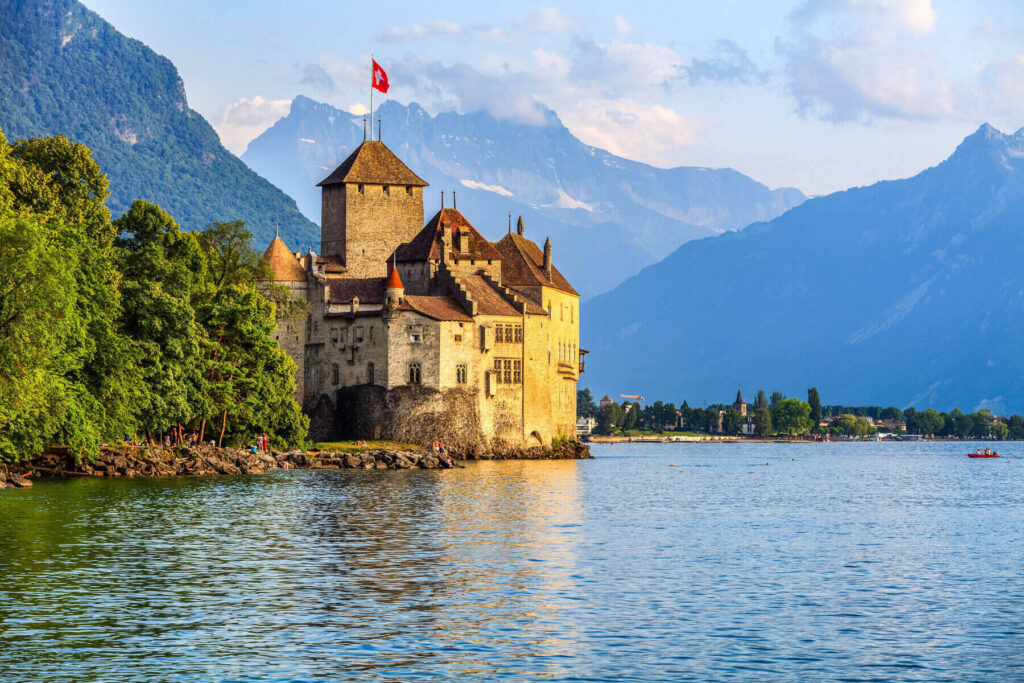
There is an excellent English-language guide to the castle, which has 28 rooms and areas open to visitors, with a fine banqueting hall and collection of armour. The castle can be very crowded in summer, but it is justly popular. The best viewpoint of the castle was probably from the lake until marred by one of the country’s most insensitively sited motorways (regrettably it is not without serious competition), which rises on piers out of the wood behind the castle. There is a landing stage by the castle for lake steamers.
Fort de Chillon
Opposite the castle is the Fort de Chillon, built deep into the rock in 1941. The labyrinth of galleries was opened in 2020 and is brought to life through augmented reality and virtual reality shows, a cinema and temporary exhibitions. Tours last 2 hours and start at 10.00, 14.00 and 16.00.
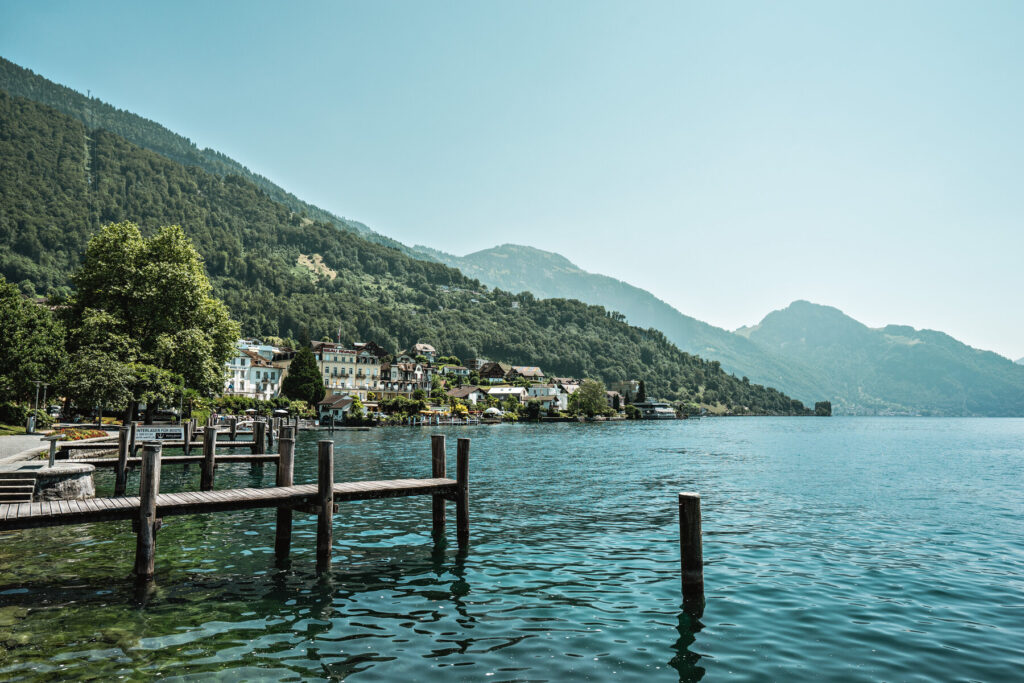
Lake Luzern
Lake Luzern’s reputation as one of Europe’s most beautiful stretches of inland water owes much to its irregular shape, creating constantly changing views, and to the grandeur of the mountains that encompass it. The shore ranges from vertiginous cliffs to gently undulating pasture grazed by cows. Although houses cover the eastern shore for some way after leaving Luzern, and there are some unfortunate stretches of road visible between Brunnen and Flüelen, the lake remains remarkably unspoilt.
The lake is 38km (24 miles) long from Luzern to Flüelen, and its deepest point is 214m (702ft) between Beckenried and Gersau. It is fed principally by the River Reuss, at Flüelen, which flows out at Luzern, and also by the rivers Engelberger Aa near Buochs and the Muota at Brunnen.
Although the entire lake is referred to as the Vierwaldstättersee, strictly speaking the name applies to the main body of water, the section beyond the narrows between Brunnen and Treib being known as Urner See, or the Lake of Uri, and that beyond the bridge at Stansstad being the Alpnacher See.
Its German name means ‘Lake of the Four Forest States’ referring to the country’s original cantons – Luzern, Schwyz, Unterwalden and Uri. The opening of the Gotthard Pass and the Schöllenen gorge to packhorses in 1230–40 made the lake a major artery for traffic between Italy and northern Europe. For centuries the boatmen, organised into guilds, enjoyed privileges granted by the cantons, and their business increased with the opening of a road over the Gotthard in 1830 and the subsequent mail coach services.
A threat appeared in 1837 in the form of the first steamship, which was greeted with a hail of stones at Flüelen and a threat to the captain of imprisonment if anyone dared to land. Sense prevailed and steamship services by various companies flourished, until 1869 when they amalgamated to form the company that still runs all services on the lake. The company has the world’s largest fleet of passenger-carrying ships on an inland lake, with a capacity of over 13,000 people.
Besides the 15 modern vessels there are five paddle steamers: Uri (1901), which is the oldest working paddle steamer in Switzerland, Unterwalden (1902), Schiller (1906), Gallia (1913) and Stadt Luzern III (1928). Once coal-fired, all have been converted to oil-firing, but the engine rooms are open to view from a gallery above them and their immaculate condition is a tribute to the engineers who care for them.
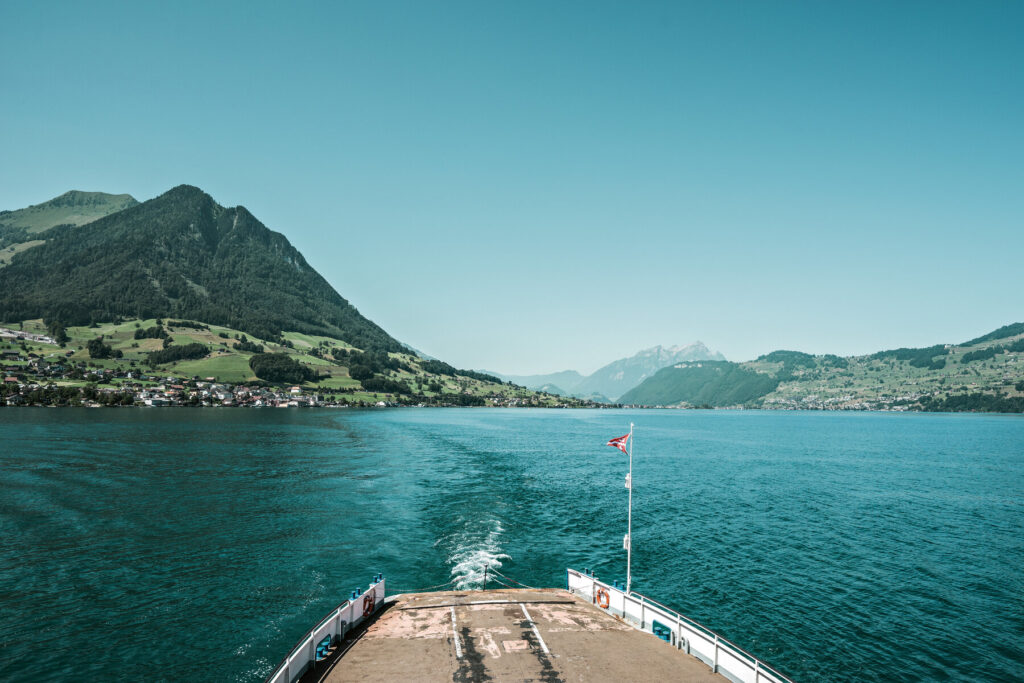
Two other paddle steamers survive as eating establishments: the Wilhelm Tell (1908) is moored at Luzern as a floating restaurant; and the Rigi (1848), which, unusually for a Swiss ship, was built in London by Ditchborne & Mare and now serves as a café on dry land outside the Transport Museum.
Breakfast or lunch on the paddlers is a pleasure not to be missed; their Empire- or Rococo-style dining rooms have been sensitively restored and the food is remarkably good. Evening dinner cruises with music and dancing are also available on modern vessels. The shipping company even brews its own craft beer; ask for the Urbräu.
The boats serve 33 points on the lake; most are substantial villages but some are delightfully small with a cluster of chalets and footpaths radiating from a tiny pier. Eight piers serve points on the Swiss Path between Rütli and Brunnen. An entire holiday could be spent using the steamer services to reach the numerous attractions around the lake.
Luzern
Luzern – Lucerne in French and commonly used in English – has become one of Switzerland’s leading tourist centres largely by virtue of its location. Not only is it beautifully situated in a fold of gentle hills on the edge of one of Europe’s finest lakes, it is also close to several of the country’s best-known mountains.
It grew up around a Benedictine convent founded in 750 and achieved some autonomy when it became a parish in 1178, but it was the opening of the Gotthard Pass to trade that acted as a catalyst to Luzern’s growth.
The old town
Luzern is a compact city, and most of its principal attractions can be reached on foot or by a short bus journey. The historic core of the city is pedestrianised and a booklet of suggested walks taking in the best buildings is available from the tourist office. Besides these buildings there are scores of smaller vernacular buildings and small courtyards with fountains, which make a stroll round the traffic-free parts of Luzern a pleasure.
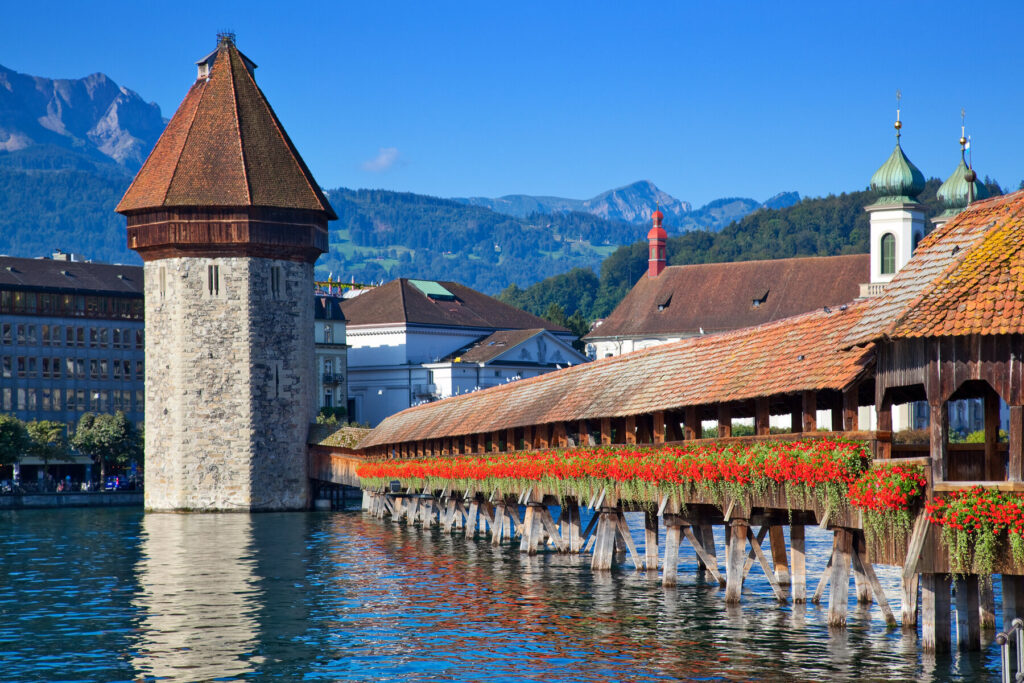
Chapel Bridge
The station (and tourist office) is only a few minutes’ walk from Luzern’s most famous attraction, the Chapel Bridge (Kapellbrücke); from both you can see the end of the main road bridge across the River Reuss where it leaves the lake. Make for it and the Chapel Bridge is to the left.
Built in the first half of the 14th century and largely destroyed by a tragic fire in August 1993, the bridge formed part of the city fortifications and was named after St Peter’s chapel at the northern end of the bridge. The Water Tower near the south end of the bridge was built in 1300 and used at various times as a treasury, archive, prison and torture chamber.
Naturally the bridge had been rebuilt many times between its construction and the fire, but it was the loss of most of the paintings that decorated the bridge which was particularly sad. However, even these were the subject of repeated restoration and replacement. The originals were executed in the early 17th century and used Swiss history and Christianity as the principal themes. Although the bridge has been shortened by 44m (144ft) since it was built, it survived several threats of demolition during the 19th century.
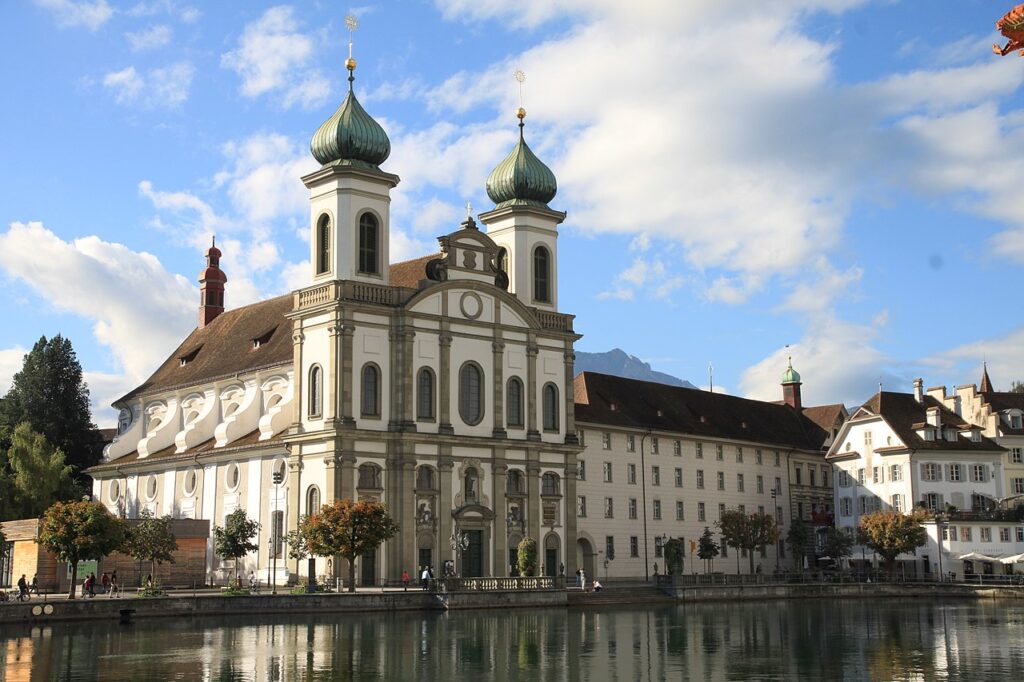
Jesuit Church of St Francis Xavier
From the southern, Bahnhofstrasse end of the bridge continue walking along the riverbank away from the lake, past the Municipal Theatre to the Jesuit Church of St Francis Xavier. This was only one of many Jesuit buildings in Luzern, their college at one time teaching about 400 pupils. Work on Switzerland’s first large Baroque church began in 1666, and it was consecrated in 1672. The identity of the architect is not known.
Inside the shell niche on the façade stands a figure of St Francis Xavier. The Jesuit origins are evident in the absence of a choir. The transition from the dark porch into the bright white interior is striking. The stucco-work and delicate colours are restrained, creating a beautiful interior, dominated by the monumental high altar built in 1681 of red stucco marble. A detailed English guidebook is available.
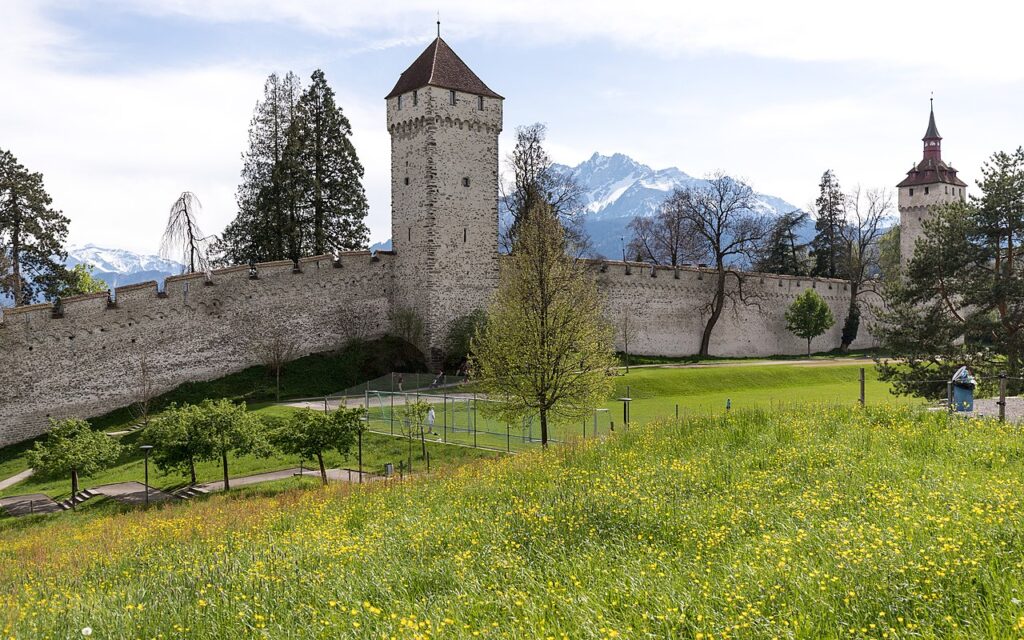
Town wall
Cross the river by the Geissmattbrücke and turn right to reach the lowest of the towers on the surviving stretch of town wall, the Nölliturm. The nine surviving towers and wall between them are a fragment of the town walls, built in 1350–1408 and largely torn down during the 19th century. The wall is a divide between old and new Luzern, and cows still graze the slopes to the north, up which an enemy would have attacked.
Some of the towers can be climbed; it is quite an ascent up the series of open steps but worth it for the view on a clear day. If you have time or energy only for one, the Zytturm is probably the most interesting on account of its 16th-century clock; the mechanism is open to view, revealing its long pulleys and crude weights in the form of lumps of rock. The Watchturm provides access to the wall-walk, but its top is sealed off.
Markets
The colourful fruit and vegetable market is held on Tuesday and Saturday mornings from 06.00 under the arcades of the Rathaus beside the River Reuss. A handicrafts market is held from 07.00 to 17.00 on the first Saturday of the month (Apr–Dec) on Weinmarkt.
A flea market is held every Saturday (May–Oct) from 07.00 on the Unter Burgerstrasse/Reusssteg. A Christmas Market is held in Franziskanerplatz from early December to a few days before Christmas from 11.00 to 21.00.
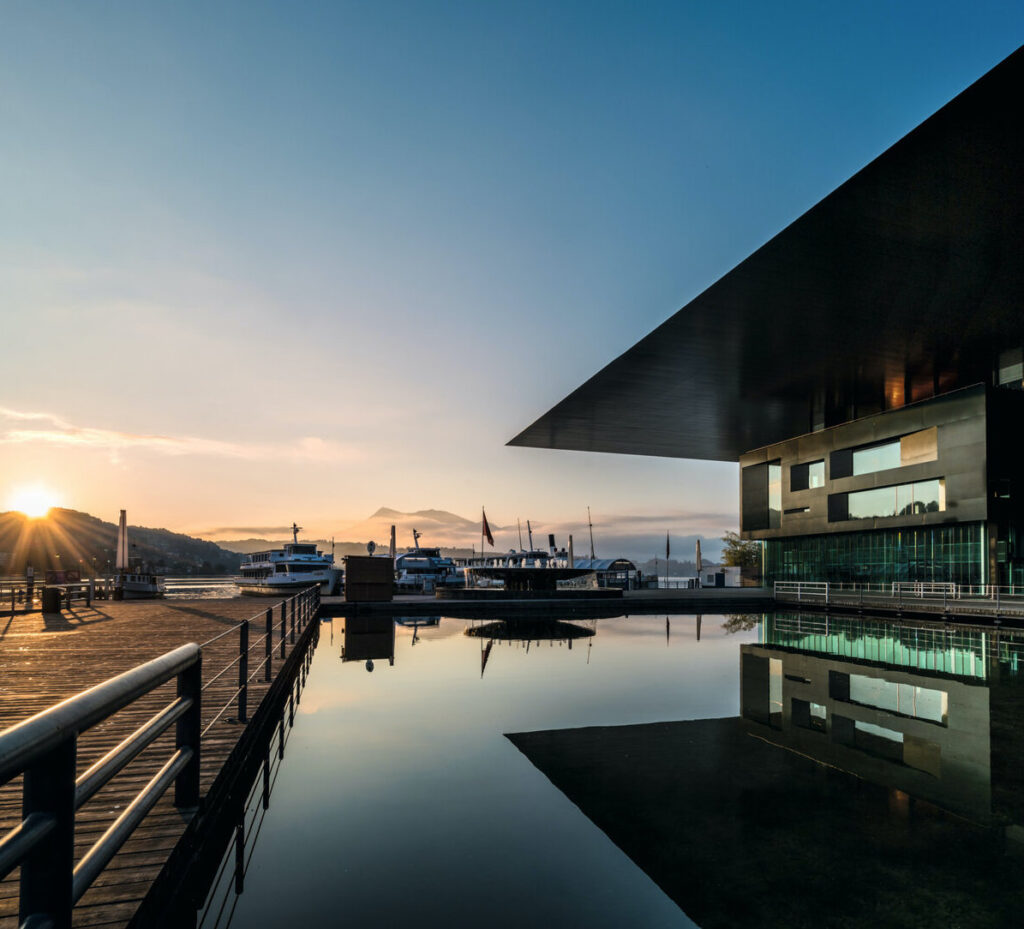
KLL Luzern
Close to the main station, the original Art Gallery was opened in 1933 but moved in 2000 into the striking new Culture and Convention Centre designed by Jean Nouvel.
Its collection focuses on Swiss art from the 16th to 20th centuries, with smaller sections on Dutch and Flemish 17th-century paintings, 20th-century German and French expressionist works, and contemporary art. However, very little if any of this permanent collection is on display, since the museum has switched to temporary exhibitions only, some of very esoteric appeal.
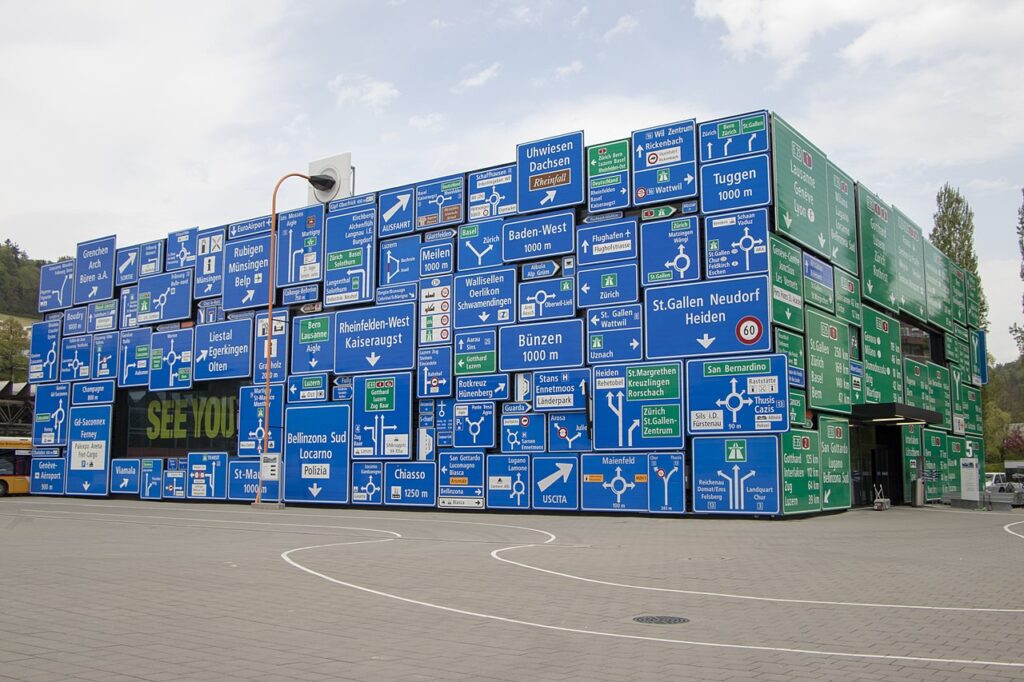
Swiss Transport Museum
Europe’s largest transport museum could easily take a full day for anyone interested in the subject. Opened in 1959 and twice enlarged since, it attracts about half a million visitors a year. It includes not only rail, air, water and road transport but also space travel, telecommunications, tourism, a cosmorama and a planetarium.
Switzerland’s first IMAX film theatre opened at the museum in 1996. The rail and water sections are understandably almost entirely Swiss-oriented, but the other sections are more international, with 35 aircraft from Britain, the United States, France and the Netherlands as well as Switzerland, and cars from a similar range of countries. Labels to exhibits are in four languages, including English.
St Gallen
For anyone interested in architecture, St Gallen deserves at least a couple of days, with its old town and the cathedral with its magnificent library, a UNESCO World Heritage Site.
The capital of the eponymous canton, its name is derived from the Irish monk Gall or Gallus, a pioneer of Christianity in Switzerland, who built a hermitage in the Steinach valley. Between 719 and 752, an abbey was built on the site of his cell and flourished to become one of the most important religious communities in the area.
Leaving the station by the main columned exit, go straight ahead across the square to the tourist office on the corner of Bahnhofplatz and St Leonhardstrasse. To reach the old town and cathedral, turn left out of the tourist office along St Leonhardstrasse towards the Broderbrunnen monument (1894). Beside it, turn right along Oberer Graben and almost immediately left into Webergasse to enter the largely pedestrianised quarter of the old town in Multergasse, straight ahead.
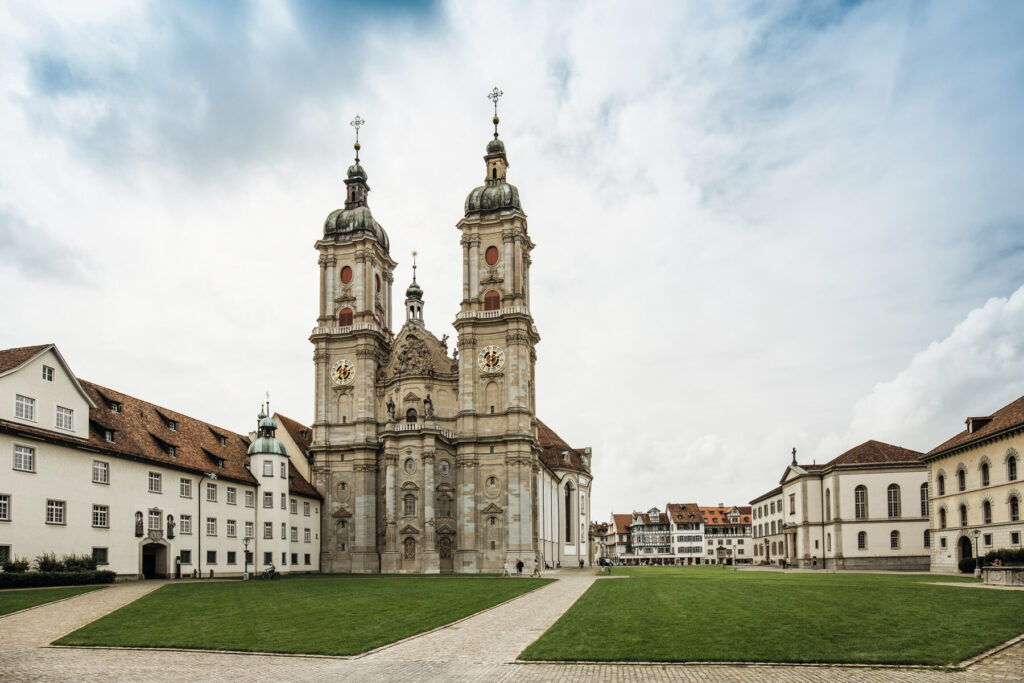
The abbey
Several architects had a hand in designing the abbey in St Gallen, which was built between 1755 and 1769, one of the last monumental buildings of the late Baroque. The long nave and central rotunda were designed by Peter Thumb, and the imposing twin-towered east front was a collaboration between J M Beer, Brother Gabriel Loser and J F Feuchtmayer, who also designed the confessionals.
With no stained glass and columns in off-white, the interior has a light, open feeling. The paintings in the rotunda depicting the advent of Christ in the presence of the blessed and those representing the monastery’s patron saints in the domes of the nave bays are by Joseph Wannenmacher.
The elaborate pulpit is decorated with four figures, while each wooden pew end has a different carved decoration. The intricate gilt wrought-iron choir screen was made in 1771 by J Mayer.
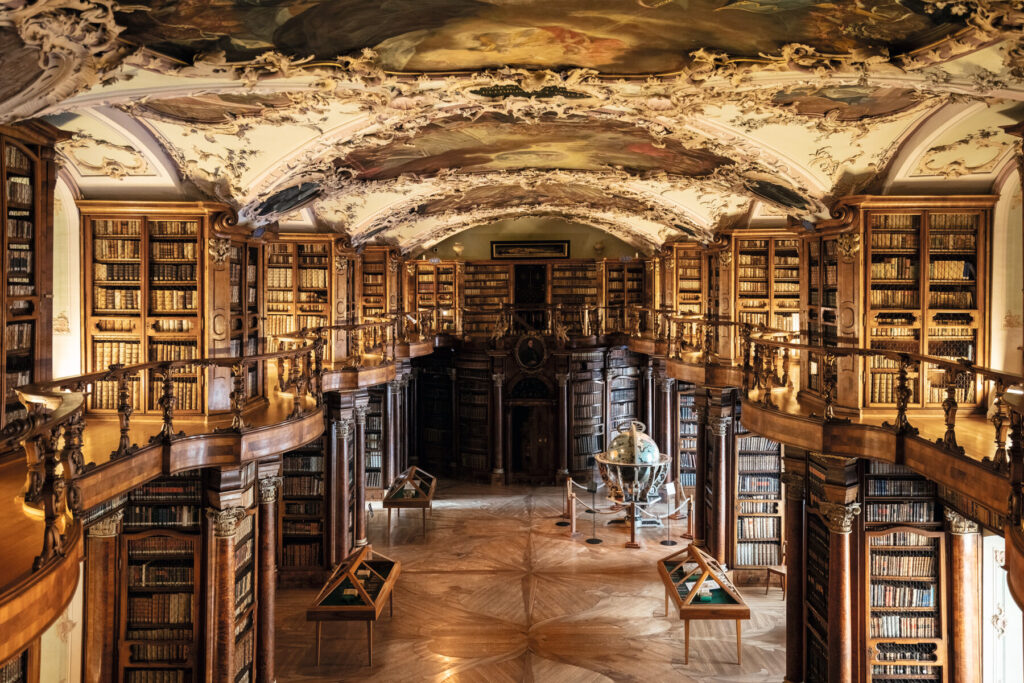
Collegiate Library
The interior of the adjacent Collegiate Library has been described as the country’s most beautiful secular Rococo interior. It describes itself, in Greek lettering above the entrance, as an ‘apothecary for the soul’. The ceiling of the two-storey room was again decorated by Joseph Wannenmacher.
Built between 1758 and 1767 following designs by Peter Thumb, the library contains one of the most important collections in Europe; particularly rare among the 130,000 volumes, 2,000 illuminated manuscripts and 1,650 early printed works are some 7th–12th-century Irish manuscripts, early scores of Gregorian chant and an 8th-century Virgil manuscript. Most of the buildings in the monastery precincts were built between the 17th century and the first half of the 19th century.
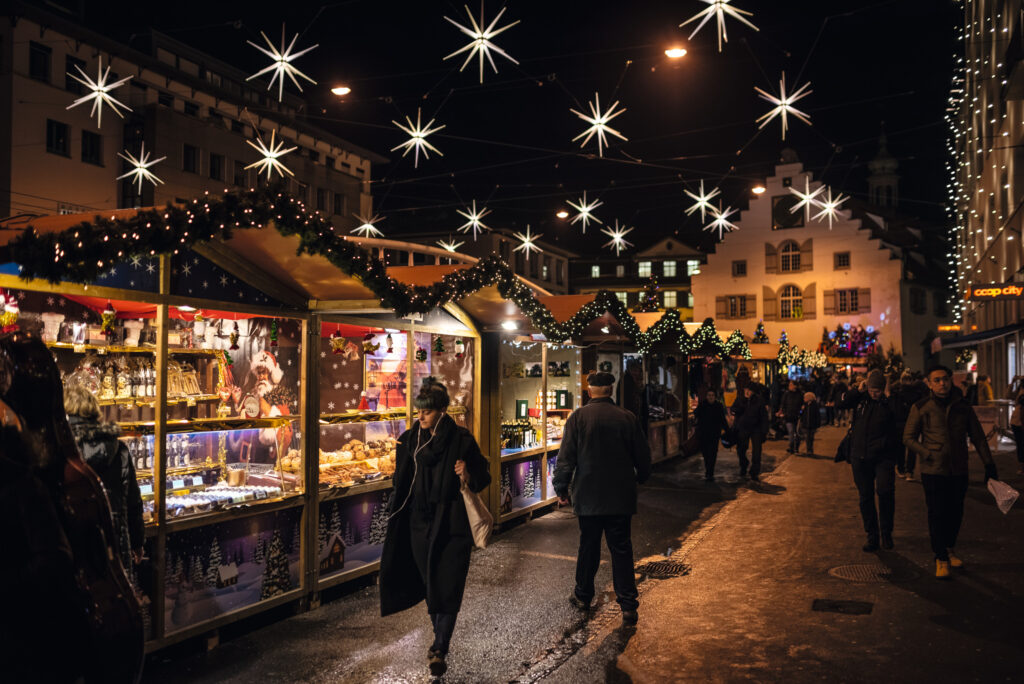
The old town
The old town is a warren of narrow streets whose dominant feature is the profusion of glorious oriel windows – 111 of them – in a most public-spirited display of one-upmanship. A rewarding hour or two can be spent ambling through these streets, in which there are plenty of cafés and restaurants.
On the northeast side of the old town, on a broad street named Bohl, is the Waaghaus, a merchants’ hall dating from 1584. From the adjacent Markt-Platz, Goliathgasse leads to the Reformed parish church of St Mangen, founded in 898 and rebuilt in 1100. Its Gothic tower dates from 1505.
Museums
Among the town’s museums is the Kulturmuseum which contains models of the town, paintings, reassembled rooms, furniture, sculpture, arms and armour, musical instruments and stamps, as well as a section for children.
The Kunstmuseum contains works by Teniers, Delacroix, Millet, Monet, Corot, Courbet, Pissarro and Sisley, and by eminent Swiss artists such as Angelica Kauffmann, Hodler and Boecklin, as well as naïve paintings by local artists.
The Natural History Museum has an exhibition of indigenous mammals and birds, living wood ants, dinosaurs, geology and mineralogy. At Vadianstrasse 2, off Oberer Graben and 5–10 minutes from the station, is the Textile Museum, devoted to lace, embroidery and linen from the Middle Ages to the present.
Theatres
The town’s opera is highly regarded in Switzerland, performing in the Stadttheater on Museumstrasse, built in 1968. The municipal orchestra plays in the Art Nouveau Music Hall (Tonhalle) opposite. Close to the station, the old locomotive three-quarter roundhouse of 1903–11 has been converted into a cultural centre with restaurant for concerts, plays, films and dance.
Zürich
Switzerland’s largest city has become a popular destination for weekend and longer breaks thanks to its famously vibrant culture and nightlife, with over 500 night spots, to match its international reputation as one of the world’s foremost financial centres. For those who know the city, it comes as no surprise that Zürich consistently ranks in the top three among world cities in the Mercer’s Quality of Life Survey.
With a delightful old town straddling the Limmat River, attractive streets of good shops, 70 museums and galleries, 14 theatres, 16 cinemas (some with 12 screens and many showing English-language films), an opera house and many concert halls, the city has a great deal to offer the visitor.
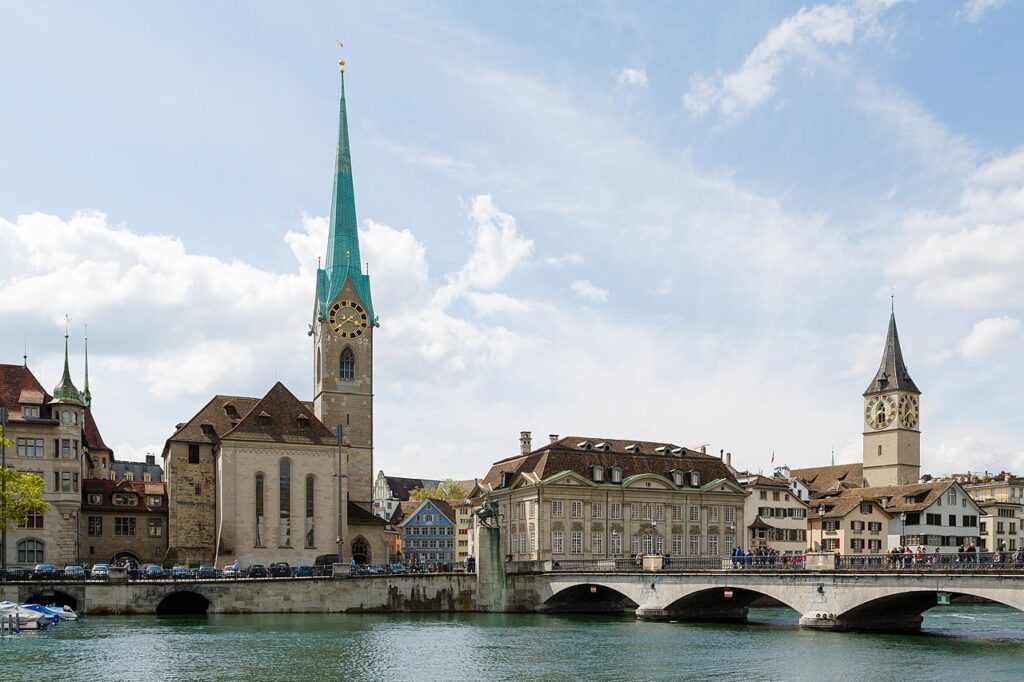
The old town
St Peterhofstatt
The street leads into the delightful St Peterhofstatt (St Peter’s Square). Sitting in the quiet shade of its central tree, surrounded by historic buildings and with the only sound coming from the modern sculptural fountain, it is hard to believe one is in the centre of the country’s largest city.
On one side is St Peter’s, Zürich’s oldest parish church, though this is the fourth building on the site. The tower dates from 1450 and has the largest church clock face in Europe, at 8.7m, which was installed in 1534. Restoration in the 1970s returned the church to its 1705 state when the nave was rebuilt.
The barrel vault has fine stucco, the pulpit is oddly positioned in the arch of the apse, and stalls line the perimeter of the whole church. The church contains the grave of the theologian Johann Caspar Lavater (1741– 1801) whose house (No 6) is on the opposite side of the square; he was visited here by Goethe. The pastor of St Peter’s for 23 years, Lavater was shot by a French soldier while tending the wounded during the seizure of the city.
Lindenhof
To the north of St Peter’s Square is the Lindenhof, a raised area on which the Roman customs post was sited, followed by a ten-towered fort. This was enlarged 800 by Charlemagne into a palace that was occupied by German kings and emperors in the following century, law being administered from under the linden tree.
The palace was destroyed in 1218 when Zürich became a free, imperial city. Today it is a park with a giant chess board and views across the Limmat.
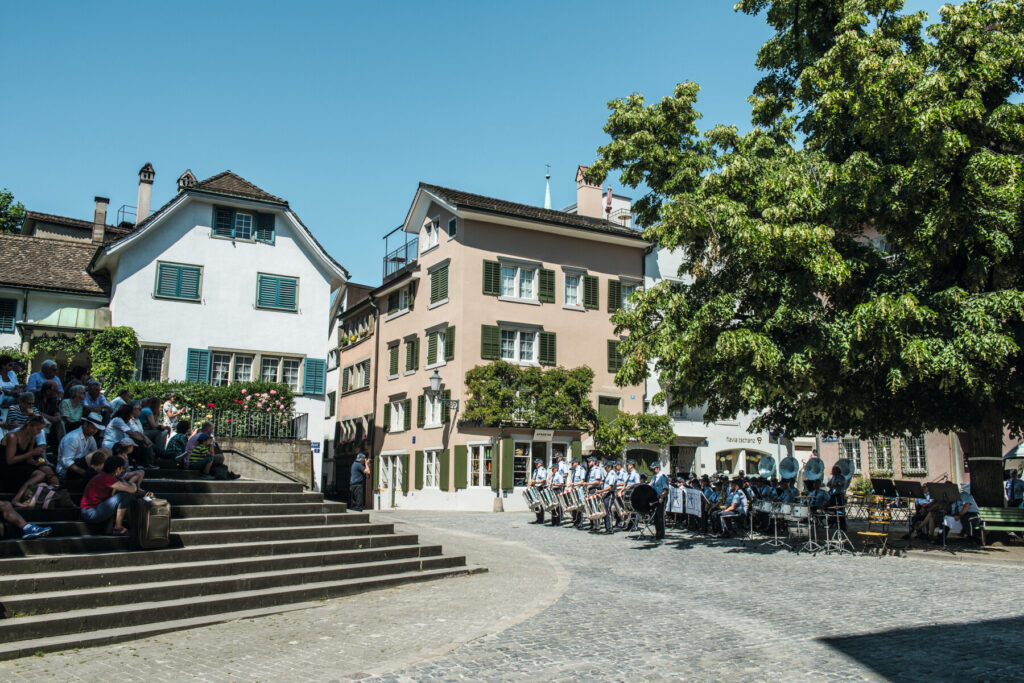
Fraumünster
To the south of St Peter’s Square is the Fraumünster, founded in 853 as a convent for noble ladies by the German King Ludwig, whose daughter Hildegard was the first abbess.
Having been suppressed in 1534 and adapted to become the Stadthaus, the convent has been reduced to a few remains: part of the Romanesque south tower, with blind arcading; part of the cloister; and most importantly the choir, with its screen of 1470, and the transept, both of which have stained glass by Marc Chagall, installed in 1970 and 1978. The keystones in the vaults of the transept are also noteworthy.
Grossmünster
Continuing into Münsterplatz, the Grossmünster is the largest church in the city, its twin towers with their octagonal lanterns dominating the skyline. Built on the site of an earlier building, the present Romanesque basilica was begun before 1100 and largely completed by 1230. It was here that Zwingli preached.
The nave is unusually high, and the church contains complete and fragmented wall paintings from the 13th and 14th centuries. In the crypt is a statue made in 1460 of Charlemagne, the founder of the original church on this site. The stained glass designed by A Giacometti was installed in 1932.
The cloisters of 1200, which are now part of the university theological faculty, should not be missed for the grotesque faces, monkeys, dragons and centaurs which decorate the 12th-century capitals and spandrels of the arched windows.
Swiss National Museum
As its name suggests, this is the most wide-ranging museum in Zürich, housed in a purpose-built neo-Gothic edifice designed to fuse various Swiss styles to resemble a castle. Completed in 1898, the museum has artefacts dating from the Stone Age to the 19th century.
The entrance is to the left of the archway, just beyond the St Gotthard stagecoach. Its sections include pre- and early history, weapons, flags, uniforms and costumes, metalwork from pewter to gold, glass, jewellery, textiles, ceramics, sculpture, paintings, musical instruments, watches and farming implements.
There is a large diorama of the 1476 Battle of Murten with 6,000 tin soldiers. There are also entire rooms from medieval and Renaissance buildings that have been dismantled and reconstructed. An extension opened in 2016 contains flexible exhibition spaces and a restaurant, Spitz, open for lunch and dinner.
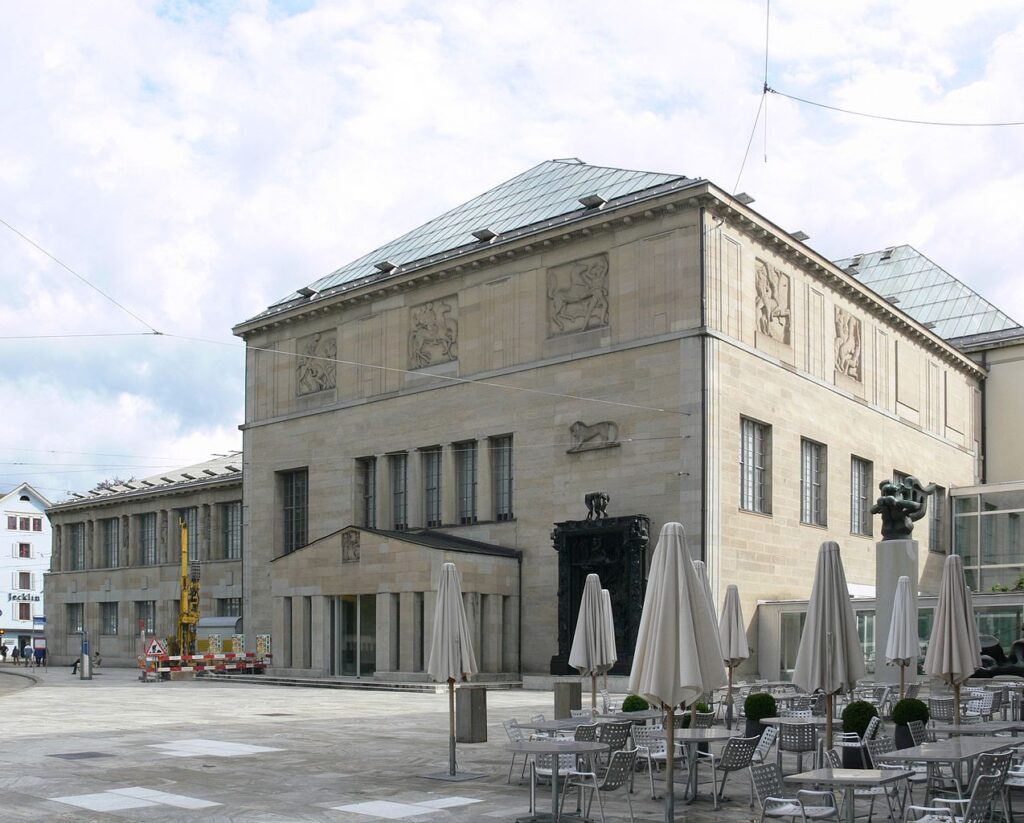
Zürich Art Gallery
Switerzland’s largest art museum has been successively enlarged since 1910 to house a large collection ranging from 15th-century religious works to late 20th-century paintings. Among the international artists represented are El Greco, Bellotto, Guardi, Canaletto, Hals, Hobbema, Cranach the Elder, Bonnard, Rodin, Gauguin, Klee, Kandinsky, Chagall, Van Gogh and Picasso.
Among the best-known paintings is the Gotthard Post, painted in 1873 by Rudolf Koller, which was commissioned as a present for Alfred Escher, whose statue stands beside the station. It has been described as the most popular painting in Swiss art. A large extension designed by Sir David Chipperfield opened in 2020 and is devoted to the Bührle collection, temporary exhibitions and art created since the 1960s.
Related books
For more information, see our guide to Switzerland:
Related articles
Sit back and watch the stunning landscapes of Switzerland from the comfort of your carriage with these seven unique train journeys.
With an enviable lakeside location, Switzerland’s largest city has much to offer.
Check out these classic coastal routes and steep mountain switchbacks
Switzerland is full of stunning villages in idyllic settings; here are five of the best.

